Похожие презентации:
DCL. Access Control. Lecture 5
1.
Protection of DBMSLECTURE 5
DCL. Access Control
IITU, ALMATY
2.
What is Access Control?• Access Control is a security term used
to refer to a set of policies for restricting
access to information, tools, and
physical locations.
• Typically access control falls under the
domain of physical access control or
information access control.
3.
Information Access ControlInformation access control restricts access to data.
Some examples include:
• a user signing into their laptop using a password;
• a user unlocking their smartphone with a thumbprint
scan;
• a Gmail user logging into their email account.
In all of these cases, software is used to authenticate and
grant authorization to users wishing to access digital
information. Both authentication and authorization are
integral components of information access control.
4.
Authentication and Authorization• Authentication is the security practice of confirming that someone
is who they claim to be, while authorization is concerned with the
level of access each user is granted.
• When a user signs into their email or online banking account, they
use a login and password combination that only they are supposed
to know. The software uses this information to authenticate the
user.
• Once authenticated, a user can only see the information they are
authorized to access. In the case of an online banking account, the
user can only see information related to their personal banking
account. A fund manager at the bank can log in to the same
application and see data on the bank’s financial holdings.
5.
Types of Access ControlCorrect configuration of access privileges is a
critical component of protecting information. A
DBMS should provide a mechanism to ensure
that only authorized users can access the
database.
DBMSs provide one or both of the following
authorization mechanisms:
• Discretionary Access Control (DAC)
• Mandatory Access Control (MAC)
6.
Discretionary Access Control(DAC)
• Each user is given appropriate access rights (or
privileges) on specific database objects.
• Typically, users obtain certain privileges when they
create an object and can pass some or all of these
privileges to other users.
• SQL supports only discretionary access control
through the GRANT and REVOKE statements.
7.
What is a privilege?• Privileges are the actions that a user is
permitted to carry out on a given base
table or view.
• Each DBMS allows a different set of
privileges.
8.
Possible privilegesThe main privileges defined by the ISO standard are:
• SELECT – the privilege to retrieve data from a table;
• INSERT – the privilege to insert new rows into a
table;
• UPDATE – the privilege to modify rows of data in a
table;
• DELETE – the privilege to delete rows of data from a
table;
The privilege may be granted for all columns of a table,
or just specific columns.
9.
GRANTThe GRANT statement is used to grant
privileges on database objects to specific users.
The format is:
GRANT {privilege_list | ALL PRIVILEGES}
ON ObjectName
TO {AuthorizationList | PUBLIC}
[WITH GRANT OPTION];
10.
GRANT example• PrivilegeList consists of one or more of the
following privileges separated by commas.
• ObjectName can be the name of a base table
or a view.
• To allow vinny to select and delete data on a
table named member:
GRANT select, delete
ON member
TO vinny;
11.
ALL PRIVILEGES• For convenience, the GRANT statement allows the
keyword ALL PRIVILEGES to be used to grant all
privileges to a user instead of having to specify the
privileges individually.
• The PRIVILEGES key word is optional in PostgreSQL,
though it is required by strict SQL.
• To give the user vinny super-user access to the book
table:
GRANT ALL PRIVILEGES
ON book
TO vinny;
12.
PUBLIC• It also provides the keyword PUBLIC to allow access to
be granted to all present and future authorized users,
not just to the users currently known to the DBMS.
• PUBLIC can be thought of as an implicitly defined group
that always includes all roles.
• Any particular role will have the sum of privileges
granted directly to it, privileges granted to any role it is
presently a member of, and privileges granted to
PUBLIC.
• Example for the accounts table:
GRANT ALL
ON accounts
TO PUBLIC;
13.
WITH GRANT OPTION• The WITH GRANT OPTION clause allows the user(s) in
AuthorizationIdList to pass the privileges they have been
given for the named object on to other users. If these users
pass a privilege on specifying WITH GRANT OPTION, the
users receiving the privilege may in turn grant it to still other
users.
• If this keyword is not specified, the receiving user(s) will not
be able to pass the privileges on to other users.
• Grant options cannot be granted to PUBLIC.
• Example:
GRANT ALL
ON book
TO vinny WITH GRANT OPTION;
14.
REVOKEThe REVOKE statement is used to take away privileges
that were granted with the GRANT statement. The
REVOKE can take away all or some of the privileges that
were previously granted to a user. The format is:
REVOKE [GRANT OPTION FOR] {privilege_list |
ALL PRIVILEGES}
ON ObjectName
FROM {AuthorizationList | PUBLIC}
[RESTRICT | CASCADE];
• The RESTRICT and CASCADE qualifiers operate
exactly as in the DROP TABLE statement.
15.
REVOKE example• So, if we wanted to remove the DELETE
privilege from vinny on the member table,
we would write:
REVOKE delete
ON member
FROM vinny;
16.
GRANT/ REVOKE with ROLE• Add users in the role (group) with:
GRANT group_role TO role1, ... ;
• Delete users from the role (group) with:
REVOKE group_role FROM role1, ... ;
17.
Books• Connolly, Thomas M. Database Systems: A Practical
Approach to Design, Implementation, and Management
/ Thomas M. Connolly, Carolyn E. Begg.- United States
of America: Pearson Education
• Garcia-Molina, H. Database system: The Complete
Book / Hector Garcia-Molina.- United States of America:
Pearson Prentice Hall
• Sharma, N. Database Fundamentals: A book for the
community by the community / Neeraj Sharma, Liviu
Perniu.- Canada
18.
Protection of DBMSLECTURE 4
Data Control Language
IITU, ALMATY
19.
Access Control• Thus far, we are the only users that interact
with the databases that we create.
• This is not the norm – typically, enterprise
databases are used by many users.
• Also, every user of an enterprise database
should not have “super-user” privileges.
• That is, some users should only be able to
select data while others should be able to
select, create, modify and destroy data.
20.
DBA• A database administrator (DBA) is the
“super-user” of a database.
• A DBA can access and modify all data.
• A DBA can create users and grant users
different privileges.
21.
SQL Structure• DDL (Data Definition Language)
• DML (Data Manipulation Language)
• TCL (Transaction Control Language)
• DCL (Data Control Language)
22.
DCL statements• SQL DCL provides the facility to create
users, grant privileges to users, and revoke
privileges from users.
• We can create users with the CREATE
USER or CREATE ROLE statements.
• We can grant privileges to users using the
GRANT statement.
• We can revoke privileges from users using
the REVOKE statement.
23.
CREATE USER• To create a user we must tell the DBMS the user’s
username and password.
• In PostgreSQL, we may issue the following
command:
CREATE USER username
WITH PASSWORD ‘password’;
• To create a user with username vinny and
password 123:
CREATE USER vinny WITH PASSWORD ‘123’;
24.
CREATE ROLE and CREATE USERCREATE USER is now an alias for CREATE
ROLE. The only difference is that when the
command is spelled CREATE USER, LOGIN is
assumed by default, whereas NOLOGIN is
assumed when the command is spelled
CREATE ROLE.
CREATE ROLE name LOGIN;
CREATE USER name;
25.
CREATE ROLE• CREATE ROLE defines a new database role
• Role is an entity that can own database
objects and have database privileges
• Role can be considered a "user", a "group", or
both depending on how it is used
• You must have CREATEROLE privilege or be
a database superuser to use this command
26.
CREATE ROLECREATE ROLE name [ [ WITH ] option [ ... ] ]
where option can be:
SUPERUSER | NOSUPERUSER
| CREATEDB | NOCREATEDB
| CREATEROLE | NOCREATEROLE
| CREATEUSER | NOCREATEUSER
| INHERIT | NOINHERIT
| LOGIN | NOLOGIN
| CONNECTION LIMIT connlimit
| PASSWORD 'password'
| VALID UNTIL 'timestamp'
| IN ROLE role_name [, ...]
| IN GROUP role_name [, ...]
| ROLE role_name [, ...]
| ADMIN role_name [, ...]
| USER role_name [, …]
…
27.
CREATE ROLE optionsSUPERUSER | NOSUPERUSER
These clauses determine whether the new role is a "superuser", who can
override all access restrictions within the database. Superuser status is
dangerous and should be used only when really needed. You must yourself be
a superuser to create a new superuser. If not specified, NOSUPERUSER is the
default.
CREATEDB | NOCREATEDB
These clauses define a role's ability to create databases. If CREATEDB is
specified, the role being defined will be allowed to create new databases.
Specifying NOCREATEDB will deny a role the ability to create databases. If not
specified, NOCREATEDB is the default.
CREATEROLE | NOCREATEROLE
These clauses determine whether a role will be permitted to create new roles
(that is, execute CREATE ROLE). A role with CREATEROLE privilege can also alter
and drop other roles. If not specified, NOCREATEROLE is the default.
CREATEUSER | NOCREATEUSER
These clauses are an obsolete, but still accepted, spelling of SUPERUSER and
NOSUPERUSER. Note that they are not equivalent to CREATEROLE as one might
naively expect!
28.
CREATE ROLE optionsINHERIT | NOINHERIT
These clauses determine whether a role "inherits" the privileges of roles
it is a member of. A role with the INHERIT attribute can automatically
use whatever database privileges have been granted to all roles it is
directly or indirectly a member of. If not specified, INHERIT is the
default.
LOGIN | NOLOGIN
These clauses determine whether a role is allowed to log in; that is,
whether the role can be given as the initial session authorization name
during client connection. A role having the LOGIN attribute can be
thought of as a user. Roles without this attribute are useful for
managing database privileges, but are not users in the usual sense of
the word. If not specified, NOLOGIN is the default, except when CREATE
ROLE is invoked through its alternative spelling CREATE USER.
29.
CREATE ROLE optionsCONNECTION LIMIT connlimit
If role can log in, this specifies how many concurrent connections
the role can make. -1 (the default) means no limit.
PASSWORD ‘password'
Sets the role's password. (A password is only of use for roles
having the LOGIN attribute, but you can nonetheless define one for
roles without it.) If you do not plan to use password
authentication you can omit this option. If no password is
specified, the password will be set to null and password
authentication will always fail for that user. A null password can
optionally be written explicitly as PASSWORD NULL.
VALID UNTIL ‘timestamp'
The VALID UNTIL clause sets a date and time after which the
role's password is no longer valid. If this clause is omitted the
password will be valid for all time.
30.
CREATE ROLE optionsIN ROLE role_name [, …]
The IN ROLE clause lists one or more existing roles to which the new role
will be immediately added as a new member.
IN GROUP role_name [, …]
IN GROUP is an obsolete spelling of IN ROLE.
ROLE role_name [, …]
The ROLE clause lists one or more existing roles which are automatically
added as members of the new role. (This in effect makes the new role a
"group".)
ADMIN role_name [, …]
The ADMIN clause is like ROLE, but the named roles are added to the new
role WITH ADMIN OPTION, giving them the right to grant membership in
this role to others.
USER role_name [, …]
The USER clause is an obsolete spelling of the ROLE clause.
31.
CREATE ROLE examples• Create a role with a password:
CREATE ROLE davide WITH LOGIN PASSWORD ‘jw8s0F4';
or
CREATE USER davide WITH PASSWORD 'jw8s0F4';
• Create a role with a password that is valid until the end of
2020. After one second has ticked in 2021, the password is
no longer valid.
CREATE ROLE miriam WITH LOGIN PASSWORD 'jw8s0F4’
VALID UNTIL ‘2022-01-01';
• Create a role that can create databases and manage roles:
CREATE ROLE admin WITH CREATEDB CREATEROLE;
32.
DROP ROLEDROP ROLE removes the specified role(s). To drop a
superuser role, you must be a superuser yourself; to drop
non-superuser roles, you must have CREATEROLE
privilege.
DROP ROLE [ IF EXISTS ] name [, …]
• IF EXISTS do not throw an error if the role does not
exist. A notice is issued in this case.
Example:
DROP ROLE davide;
33.
ALTER ROLEALTER ROLE role_specification [ WITH ] option [ ... ]
where option can be:
SUPERUSER | NOSUPERUSER
| CREATEDB | NOCREATEDB
| CREATEROLE | NOCREATEROLE
| CREATEUSER | NOCREATEUSER
| INHERIT | NOINHERIT
| LOGIN | NOLOGIN
| CONNECTION LIMIT connlimit
| PASSWORD 'password'
| VALID UNTIL ‘timestamp'
…
ALTER ROLE name RENAME TO new_name
34.
Books• Connolly, Thomas M. Database Systems: A Practical
Approach to Design, Implementation, and Management
/ Thomas M. Connolly, Carolyn E. Begg.- United States
of America: Pearson Education
• Garcia-Molina, H. Database system: The Complete
Book / Hector Garcia-Molina.- United States of America:
Pearson Prentice Hall
• Sharma, N. Database Fundamentals: A book for the
community by the community / Neeraj Sharma, Liviu
Perniu.- Canada
35.
Protection of DBMSLECTURE 2
Views
IITU, ALMATY
36.
ViewView is a virtual table based on the result-set
of an SQL statement.
View contains rows and columns, just like a
real table. Fields in a view are fields from one or
more real (physical) tables of the database.
37.
View• Views do not physically exist. Views are virtual
tables.
• You can add SQL functions, WHERE, and JOIN
statements to a view and present the data as if the
data were coming from one single table.
• A view always shows up-to-date data. The DB engine
recreates the data, using the view's SQL statement,
every time a user queries a view.
• Views are supported by all main DBMS.
38.
Use of view: case 1• In some cases, we may not want users to
see all information in a table(s).
• Users need to be restricted from accessing
this information.
39.
Use of view: case 2• In other case, a complex set of relational tables
does not lend itself to easy use by non-database
professionals.
• Consider a clerk at the library performing an
audit. This clerk is only interested in the names
of each member and the number of books those
member have borrowed.
• Should this clerk have to write complex queries
involving aggregate functions and joins over
multiple tables? Probably not.
40.
Use of viewsViews allow users to do the following:
• Restrict access to the data such that a user can
only see limited data instead of complete table.
• Structure data in a way that users or classes of
users find natural or intuitive.
• Summarize data from various tables, which can
be used to generate reports.
41.
CREATE VIEW• A view is created using the CREATE VIEW
SQL command with SELECT on the defining
tables.
• Syntax:
CREATE VIEW view_name
AS
SELECT …;
42.
CREATE OR REPLACE VIEWCREATE OR REPLACE VIEW is similar, but if a
view of the same name already exists, it is replaced.
The new query must generate the same columns
that were generated by the existing view query (that
is, the same column names in the same order and
with the same data types), but it may add additional
columns to the end of the list.
The calculations giving rise to the output columns
may be completely different.
CREATE
OR
REPLACE
VIEW
is
a
PostgreSQL extension.
43.
CREATE VIEW example• To create a view Students_info with only first
and last names from the Students table.
CREATE VIEW Students_info
AS
SELECT fname, lname
FROM Students;
44.
CREATE OR REPLACE VIEWSyntax:
CREATE OR REPLACE VIEW view_name
AS
SELECT …;
Example:
CREATE OR REPLACE VIEW Students_info
AS
SELECT fname, lname, stud_id
FROM Students;
45.
DROP VIEW• Views can be deleted with the DROP
VIEW statement.
• To delete the Students_groups view
created on the previous slide.
DROP VIEW Students_groups;
46.
View with join• Views may also be built by joining many tables.
• To create a view with last name and group’s
name of each student.
CREATE VIEW Students_groups
AS
SELECT s.stud_id, s.lname, g.group_id, g.name
FROM Students s, Groups g
WHERE s.group_id = g.group_id;
47.
View updating• Updates to views are not simple. Recall
that views are virtual tables – they do not
physically exist.
• Any updates to views must be mapped onto
the defining tables.
• If an update cannot be mapped, then a
view is unupdatable.
48.
View updatingFor a view to be updatable, the DBMS must be
able to trace any row or column back to its row or
column in the source table.
In general, a view is updatable if it contains a
single table and contains a primary key.
Generally, a view is not updatable if it contains
a join operation.
A view is definitely not updatable if it involves
an aggregate function or a subquery.
49.
View updating• Use UPDATE SQL DML command to
update the Students_info view:
UPDATE Students_info
SET fname = 'Alan'
WHERE stud_id = 3;
• It’s identical to operation in the physical
table Students.
50.
MigrationSuppose we slightly altered the view to include
only students with group_id = 2.
CREATE VIEW Group_2
AS
SELECT stud_id, fname, lname, group_id
FROM Students
WHERE group_id = 2;
51.
Migration• One problem with updatable views are the rows
that we attempt to insert may violate the
selection condition.
• Suppose we tried to update the view to change
the student’s group_id to 3.
• Will that student still be part of the view?
• No, that student will not be part of the view. That
row will migrate from the view.
52.
Using views as physical tables• Views can be used like any other real tables in
DB.
• Also you can build view based on other views.
CREATE VIEW Students_info AS
SELECT fname, lname
FROM Students;
• SELECT from the view:
SELECT * FROM Students_info;
53.
Database Security: Access Control• The view mechanism provides a powerful and flexible
security mechanism by hiding parts of the database
from certain users.
• The user is not aware of the existence of any attributes
or rows that are missing from the view.
• A view can be defined over several relations with a user
being granted the appropriate privilege to use it, but not
to use the base relations.
• In this way, using a view is more restrictive than simply
having certain privileges granted to a user on the base
relation(s).
54.
Summary• A view is the dynamic result of one or more relational
operations operating on the base relations to produce
another relation.
• A view is a virtual relation that does not actually exist in
the database, but is produced upon request by a
particular user, at the time of request.
• Views take very little space to store; the database
contains only the definition of a view, not a copy of all the
data that it presents.
55.
SummaryViews can represent a subset of the data contained in a
table.
• A view can limit the degree of exposure of the tables
to the outer world: a given user may have permission
to query the view, while denied access to the rest of
the base table.
• Views can join and simplify multiple tables into a
single virtual table. Views can hide the complexity of
data.
56.
Books• Connolly, Thomas M. Database Systems: A Practical
Approach to Design, Implementation, and Management
/ Thomas M. Connolly, Carolyn E. Begg.- United States
of America: Pearson Education
• Garcia-Molina, H. Database system: The Complete
Book / Hector Garcia-Molina.- United States of America:
Pearson Prentice Hall
• Sharma, N. Database Fundamentals: A book for the
community by the community / Neeraj Sharma, Liviu
Perniu.- Canada
57.
Protection of DBMSLECTURE 1
Introduction
IITU, ALMATY
58.
Course Information• Lectures
• Lab works
(individual work, University database)
• Project
(teams of 1-2 students, individual topic)
• Midterm / End of term – Quiz
59.
DBMS Security• Data is a valuable resource that must be strictly
controlled and managed. Corporate data have
strategic importance to a company and should be
kept secure and confidential.
• DBMS must ensure that the database is secure. The
term security refers to the protection of the database
against unauthorized access, either intentional or
accidental.
• Besides the services provided by the DBMS,
discussions on database security also includes
broader issues related to data protection.
60.
Today’s lecture• This lecture describes the scope of database
security.
• We discuss why organizations must take
potential threats to their computer systems
seriously.
• We identify the range of threats and their
consequences on computer systems.
61.
Database Security• Database Security - mechanisms that protect
the database against intentional or accidental
threats.
• Security considerations apply not only to the
data held in a database: security breaches
may affect other parts of the system, which
may in turn affect the database.
• Consequently, database security includes
hardware, software, people, data.
62.
Database Security• Effective security requires appropriate controls,
which are defined in specific system objectives.
• The need for security has often been ignored in
the past but is now increasingly recognized as
important.
• The reason for this change is the growing amount
of important corporate data stored on computers.
Any loss or inaccessibility of this data can be
catastrophic.
63.
Risk situationsDatabase represents an essential corporate resource that
should be properly secured using appropriate controls.
Database security is considered in the following situations:
• theft and fraud;
• loss of confidentiality (secrecy);
• loss of privacy;
• loss of integrity;
• loss of availability.
These situations represent areas in which organizations
should seek to reduce risks. In some situations, these
areas are closely related such that an activity that leads to
loss in one area may also lead to loss in another.
64.
Theft and fraud• Theft and fraud affect not only the database
environment but also the entire organization.
• As it is people who perpetrate such activities,
attention should focus on reducing the
opportunities for this occurring.
• Theft and fraud do not necessarily alter data,
as is the cases of loss of confidentiality or loss
of privacy.
65.
Confidentiality and Privacy• Confidentiality refers to the need to maintain
secrecy over data, but usually only data which is
critical to the organization.
• Privacy refers to the need to protect data about
individuals.
• Security breaches resulting in loss of
confidentiality could, for instance, lead to loss of
competitiveness, and loss of privacy could lead to
legal action against the organization.
66.
Loss of data integrity• Loss of data integrity results in invalid or
corrupted data, which may seriously affect the
work in the organization. Many organizations
now provide continuous operation, so called
24/7 availability (that is, 24 hours a day, 7
days a week).
67.
Loss of availability• Loss of availability means that the data, or
the system, or both cannot be accessed,
which can seriously affect the organization’s
financial performance.
• In some cases, events that cause a system to
be unavailable may also cause data
corruption.
68.
Threats• Threat - any situation or event, whether intentional or
accidental, that may adversely affect a system and
consequently the organization.
• Threat may be caused by a situation or event involving a
person, action, or circumstance that is likely to bring harm
to the organization.
• The problem facing any organization is to identify all
possible threats. Therefore, organizations should invest
time and effort in identifying threats.
• Previous slides define areas of loss from intentional or
unintentional activities. While some types of threat can be
either intentional or unintentional, the impact remains the
same.
• Any threat must be viewed as a potential security breach
which, if successful, will have a certain impact.
69.
ThreatsExamples of various threats with areas on which they may
have an impact.
70.
Threats• Organization's security depends on the availability of
countermeasures and an action plan.
• For example, if hardware fails and secondary storage
becomes damaged, all processing operations must be
stopped until the problem is resolved. Recovery depends
on the time of the last backup and the recovery time.
• Organization should define types of threats and
countermeasures, taking into account costs of their
implementation.
• It is ineffective to waste time, effort, money on potential
threats that could result in minor inconvenience.
However, rare events should be considered if their impact
is significant.
71.
Classifications of Threats1. by purpose of threat implementation
2. by the origin of a threat
3. by localization of threat source
4. by location of threat source
5. by way of impact on a data storage of information
system
6. by the nature of the impact on the information
system
72.
1. Classificationby purpose of threat implementation
• Violation of the confidentiality of information
• use of information in the system by persons or
processes that have not been identified by the
owners
• Violation of information integrity
• modification or destruction of information to devalue
it due to loss of correspondence with the state of the
real world
• Total or partial disruption of operation due to failure or
improper change in the operation of system
components, including their modification or replacement
73.
2. Classificationby the origin of a threat
• Natural threats
• threats caused by the impact on the
database of physical processes or
spontaneously
developing
natural
phenomena
• Artificial threats
• threats to information security of DBMS
related to human activities
74.
3. Classificationby localization of threat source
• Threats, a direct source of which is a human
• Threats, a direct source of which is the usual
software and hardware of the IS
• Threats, a direct source of which is
unauthorized software and hardware
• Threats, a direct source of which is a habitat.
75.
4. Classificationby location of threat source
• Threats, the source of which is located outside
the controlled area of the IS’s location.
• Threats, the source of which is located within
the controlled area of the IS, including the
location of client terminals and servers.
76.
5. Classificationby way of impact on a data storage
of the IS
• Threat of information security of data stored
on external devices.
• Threat of information security of data stored in
the RAM of servers and client computers.
• Threat of information security of data
displayed on the user's terminal or printer.
77.
6. Classificationby the nature of the impact on the IS
• Active impact
• user actions that go beyond his
responsibilities
• Passive impact
• the user observes values of DBMS
parameters
and
various
indirect
characteristics in order to obtain confidential
information
78.
ExampleMovie:
The Social Network
(2010)
Hacking Scene:
~ 9 - 12 min
79.
Example: ClassificationClassification
Type
by purpose of threat
implementation
Mark Zuckerberg used face books, where people provided their
photos, that means that he violated the confidentiality of
information
by the origin of a
threat
We can classify that threat as an artificial, because Mark did all the
work himself
by localization of
threat source
In this case, the only threat was caused by a human(direct source –
Mark)
by location of threat
source
Mark had access to all sources and information systems as a student
of Harvard, so it can be classified as a threat, the source of which
is located within the controlled area of the information system
by way of impact on
a data storage of
the information
system
Mark used the information that was stored on servers, so it’s
classified as a threat of information security of data stored in the
RAM of servers
by the nature of the
impact on the
information system
It was shown that Mark did active impact (the user actions that go
beyond his responsibilities)
80.
Books• Connolly, Thomas M. Database Systems: A Practical
Approach to Design, Implementation, and Management
/ Thomas M. Connolly, Carolyn E. Begg.- United States
of America: Pearson Education
• Garcia-Molina, H. Database system: The Complete
Book / Hector Garcia-Molina.- United States of America:
Pearson Prentice Hall
• Sharma, N. Database Fundamentals: A book for the
community by the community / Neeraj Sharma, Liviu
Perniu.- Canada
81.
Summary of potential threats82.
Summary• Database security aims to minimize losses
caused by unacceptable events in a costeffective way without constraining users.
• Computer-based crime has increased
significantly recently and will continue to
grow in the coming years.
83.
Protection of DBMSLECTURE 10
Backup and Recovery
IITU, ALMATY
84.
Content• Backup
• Recovery (Restore)
85.
Database Backup• Backup is the process of periodically taking a copy
of the database to offline storage.
• A DBMS should provide backup facilities to assist
with the recovery of a database following failure.
• It is always advisable to make backup copies of the
database at regular intervals and to ensure that the
copies are in a secure location.
• In the event of a failure that renders the database
unusable, the backup copy is used to restore the
database to the latest possible consistent state.
86.
Database BackupA DBMS should provide the following facilities to
assist with recovery:
• a backup mechanism, which makes backup
copies of the database;
• a recovery manager, which allows the system
to restore the database to a consistent state
following a failure.
87.
Database Backup• PostgreSQL provides pg_dump and pg_dumpall
tools to backup databases.
• pg_dump - extract a database into a script file or
other archive file.
• It makes consistent backups even if the database is
being used concurrently. pg_dump does not block
other users accessing the database.
• pg_dump only dumps a single database. To backup
global objects that are common to all databases in
a cluster, such as roles, use pg_dumpall.
88.
Backup with pgAdmin• The pgAdmin provides an intuitive user
interface that allows you to backup a
database using pg_dump tool.
• For example to backup the University
database, you can follow the steps.
89.
Backup with pgAdmin• First, right mouse click on the University database,
and choose the Backup menu item.
90.
Backup with pgAdmin• Second, enter the output file name and choose the
file format.
91.
Backup formatsPlain. Output a plain-text SQL script file.
Custom. Output a custom-format archive suitable for input
into pg_restore. Together with the directory output format, this is the
most flexible output format in that it allows manual selection and
reordering of archived items during restore. This format is also
compressed by default.
Directory. Output a directory-format archive suitable for input
into pg_restore. This will create a directory with one file for each table,
plus a so-called Table of Contents file describing the dumped objects in
a machine-readable format that pg_restore can read. This format is
compressed by default.
Tar. Output a tar-format archive suitable for input into pg_restore. The
tar format is compatible with the directory format: extracting a tar-format
archive produces a valid directory-format archive. However, the tar
format does not support compression. Also, when using tar format the
relative order of table data items cannot be changed during restore.
92.
Backup with pgAdmin• pgAdmin backup tool provides various dump
options as follows:
93.
Backup with pgAdmin• Third, click Backup button to start performing a
backup.
• pgAdmin provides detailed information of the
backup process.
94.
Recovery• Dumps can be output in script or archive file formats.
• Script dumps are plain-text files containing the SQL
commands required to reconstruct the database to the
state it was in at the time it was saved. To restore from
such a script, feed it to psql.
• Script files can be used to reconstruct the database
even on other machines and other architectures; with
some modifications, even on other SQL database
products.
• The alternative archive file formats must be used with
pg_restore to rebuild the database. They allow to be
selective about what is restored.
95.
RecoveryIn PostgreSQL, you can restore a database in
two ways:
• Using psql to restore plain SQL script file
generated by pg_dump and pg_dumpall tools.
• Using
pg_restore to restore tar file and
directory format created by the pg_dump tool.
96.
Recovery with pgAdmin• If you want to run the recovery via an intuitive
user interface instead of the command line,
you can use the pgAdmin restore tool.
• The following example demonstrates how to
restore the University database.
97.
Recovery with pgAdmin• First, drop
database.
the
• Second, create
database.
an
existing
University
empty
University
98.
Recovery with pgAdmin• Third, choose the University database, right mouse
click and choose the Restore menu item.
99.
Recovery with pgAdmin• Fourth, choose appropriate options such as backed
up file, role, restore options, and click the Restore
button to start restoring the database.
100.
Recovery with pgAdmin• Possible restore options:
101.
Recovery with pgAdmin• pgAdmin displays detailed information.
102.
Сopy DB within the same server• While the previous method copies a database from a
server to another, here is another one to copy database
within the same server (for testing purposes, for
example).
• PostgreSQL makes it easy to do it via the CREATE
DATABASE statement as follows:
CREATE DATABASE targetdb
WITH TEMPLATE sourcedb;
• This statement copies the sourcedb to the targetdb.
103.
Сopy DB within the same server• For example, to copy the University database
to the University_copy database, you use the
following statement:
CREATE DATABASE University_copy
WITH TEMPLATE University;
104.
Сopy DB with pgAdmin• Firstly, to create a new database:
Databases -> Create -> Database
• To create a copy of the database, write the Database
name (General tab) and Template (Definition tab).
105.
Сopy DB with pgAdmin• Resulting SQL script (SQL tab):
106.
Books• Connolly, Thomas M. Database Systems: A Practical
Approach to Design, Implementation, and Management /
Thomas M. Connolly, Carolyn E. Begg.- United States of
America: Pearson Education
• Garcia-Molina, H. Database system: The Complete Book /
Hector Garcia-Molina.- United States of America: Pearson
Prentice Hall
• Sharma, N. Database Fundamentals: A book for the
community by the community / Neeraj Sharma, Liviu Perniu.Canada
• www.postgresql.org
107.
Protection of DBMSLECTURE 11
SQL Injections
IITU, ALMATY
108.
Today’s lecture• Embedded SQL
• SQL injections
109.
Embedded SQL• Embedded SQL is a method of combining
the computing power of a programming
language and the database manipulation
capabilities of SQL.
• Embedded SQL statements are SQL
statements written inline with the program
source code of the host language.
110.
Embedded SQL• We can write SQL statements in code written
in a programming languages like Java, C++,
and etc.
• The SQL statements are transferred to the
database that executes the query.
• The results of the query are returned to the
application.
111.
Embedded SQL112.
Embedded SQL• Formally, the process of placing an SQL
statement within an application to query a
database is known as embedding a SQL.
• The language in which we embed SQL is
known as the host language.
• Most modern computer languages, including
Java, C++, PHP, and Python, may serve as a
host language to SQL.
113.
Embedded SQL• Embedded SQL comes in two flavors: static
and dynamic.
• We are familiar with writing static SQL
statements. These SQL statements are
complete queries that can run inside a
database. For example:
SELECT * FROM Students;
114.
Embedded SQL• Dynamic embedded SQL statements allow to place
the value of program variables in queries.
• Suppose we have a variable with name studentname
and value ‘John’. We can write a query to select all
data from the Students table where the fname is the
value of studentname :
string SQLQuery="SELECT * FROM Students
WHERE fname=' "+studentname+" ‘ “;
• Note, when the previous command is executed, the
string SQLQuery becomes
SELECT * FROM Students WHERE fname = 'John'
115.
SQL Injection• SQL injection is a code injection technique
that might destroy your database.
• SQL injection is one of the most common
web hacking techniques.
• SQL injection is the placement of malicious
code in SQL statements, via web page input.
116.
SQL in Web Pages• SQL injection usually occurs when you ask a user for
input, like their username/userid, and instead of a
name/id, the user gives you an SQL statement that you
will unknowingly run on your database.
117.
Anatomy of an SQL attackSQL Injection
Web Application
Server
SQL
Database
118.
SQL in Web Pages• The following example creates a SELECT statement
by adding a variable (txtUserId) to a select string. The
variable is fetched from user input:
sql = "SELECT * FROM Users WHERE Username =
‘ " + txtUsername + ” ’ ";
txtUsername
119.
SQL in Web Pages• A similar query is generally used from the web
application in order to authenticate a user.
• If the query returns a value, it means that
inside the database a user with that set of
credentials exists, then the user is allowed to
login to the system, otherwise access is
denied.
• The values of the input fields are generally
obtained from the user through a web form.
120.
SQL in Web Pages• Here is an example of a user login on a web site:
sql = "SELECT * FROM Users WHERE Name = ' " +
uName + " ' AND Pass = ' " + uPass + '' ' ’’
• Result:
SELECT * FROM Users
WHERE Name ='John Doe' AND Pass ='myPass'
121.
SQL injection examplesSQL Injection Based on:
• 1=1 is Always True
• ' ' = ' ' is Always True
• Batched SQL Statements
122.
1=1 is Always True• The original purpose of the code is to create an SQL
statement to select a user with a given user id:
SELECT * FROM Users WHERE UserId = …
• If there is nothing to prevent a user from entering
"wrong" input, the user can enter some input like this:
• Then, the SQL statement will look like this:
SELECT * FROM Users WHERE UserId = 105 OR 1=1
123.
1=1 is Always True• The following SQL is valid and will return ALL rows from
the "Users" table, since 1=1 is always TRUE.
SELECT *
FROM Users
WHERE UserId = 105 OR 1=1
• In this way the system has authenticated the user
without knowing the username and password.In some
systems the first row of a user table would be an
administrator user. This may be the profile returned in
some cases.
124.
1=1 is Always TrueSELECT * FROM Users WHERE UserId = 105 OR 1=1
• The SQL statement above is much the same as this:
SELECT UserId, Name, Password
FROM Users
WHERE UserId = 105 OR 1=1
• A hacker might get access to all the user names and
passwords in a database, by simply inserting ”105 OR
1=1” into the input field.
125.
' ' = ' ' is Always True• Here is an example of a user login on a web site:
sql = "SELECT * FROM Users WHERE Name = ' " +
uName + " ' AND Pass = ' " + uPass + '' ' ’’
• Result:
SELECT * FROM Users
WHERE Name ='John Doe' AND Pass ='myPass'
126.
' ' = ' ' is Always True• A hacker might get access to user names and
passwords in a database by simply inserting
' OR ' ' = ' into the user name or password text
box:
127.
' ' = ' ' is Always True• The code at the server will create a valid SQL
statement like this:
SELECT *
FROM Users
WHERE Name = ' ' OR ' ' = ' '
AND Pass = ' ' OR ' ' = ' '
• The SQL above is valid and will return all rows
from the "Users" table, since ' ' = ' ' is always
TRUE.
128.
Batched SQL Statements• DBMSs support batched SQL statement.
• A batch of SQL statements is a group of two or
more SQL statements, separated by semicolons.
• The SQL statement below will return all rows from
the "Users" table, then delete the "Suppliers"
table:
SELECT * FROM Users; DROP TABLE Suppliers
129.
Batched SQL Statementssql = "SELECT * FROM Users WHERE UserId = " +
txtUserId;
• The following input:
• The valid SQL statement would look like this:
SELECT * FROM Users
WHERE UserId = 105;
DROP TABLE Suppliers;
130.
ReactionYou've just detected a SQL injection attack.
Your actions:
1. As quickly as possible disable access and prevent the
attacker from doing anything else. Their next injected
SQL statement could be a DROP TABLE. Do as much
as is needed to stop it right away - don't worry about
fixing the hole yet.
2. Once things are disabled, start patching up the holes.
Check your logs carefully to see if this was an isolated
event, or if the hole had been used before.
3. Learn why this happened in the first place.
131.
Detection• If someone were to start a SQL injection attack
against your site right now, would you even
know?
• Fortunately, SQL injection attacks almost
always generate some SQL errors as the
attacker tries to work around your SQL.
• This is the number one way to detect an attack
while it is happening.
132.
Detection• In addition to pure SQL errors, permission
errors often occur as well, as the attacker tries
to do something not allowed by the current
database user.
• Remember to never treat a strange error as an
uninteresting isolated event, or assume that it is
probably one of your developers. Follow up on
everything.
133.
Detection• Sometimes, when the attacker is very good, no
SQL errors are generated, and the problems
have to be detected in other ways.
• One way is to scan for common SQL injection
items. In most cases, attacker access to your
database is fairly limited without knowing the
names of your tables, columns, functions, and
views, so one thing to look for is references to
system tables and system views.
134.
PreventionPreventing SQL injection is mostly a matter of
following some standard software development
practices:
• Never assume any database input is safe
• Be proactive in looking for problems
• Use the least privileges possible
• Keep your software up to date
• Teach people about SQL injection
• More than one set of eyes
135.
Conclusion• If you take a user input through a webpage and insert it into
a SQL database, there is a chance that you have left
yourself wide open for a security issue known as the SQL
Injection.
• Injection usually occurs when you ask a user for input, like
their name and instead of a name they give you a SQL
statement that you will unknowingly run on your database.
Never trust user provided data, process this data only after
validation.
• A successful SQL injection can read, modify sensitive data
from the database, and can also delete data from a
database. It also enables the hacker to perform
administrative operations on the database such as dropping
databases.
136.
Books• Connolly, Thomas M. Database Systems: A Practical
Approach to Design, Implementation, and Management /
Thomas M. Connolly, Carolyn E. Begg.- United States of
America: Pearson Education
• Garcia-Molina, H. Database system: The Complete Book /
Hector Garcia-Molina.- United States of America: Pearson
Prentice Hall
• Sharma, N. Database Fundamentals: A book for the
community by the community / Neeraj Sharma, Liviu Perniu.Canada
• www.postgresql.org
137.
Protection of DBMSLECTURE 9
Database Activity
Monitoring
IITU, ALMATY
138.
Statistics Collector• PostgreSQL's statistics collector is a subsystem that
supports collection and reporting of information about
server activity.
• Presently, the collector can count accesses to tables.
It also tracks the total number of rows in each table,
and and analyze actions for each table.
• PostgreSQL also supports reporting dynamic
information about exactly what is going on in the
system right now, such as the exact command
currently being executed by other server processes,
and which other connections exist in the system.
139.
Viewing Statistics• When using the statistics to monitor collected
data, it is important to realize that the
information does not update instantaneously.
• Each individual server process transmits new
statistical counts to the collector just before
going idle; so a query or transaction still in
progress does not affect the displayed totals.
• Also, the collector itself emits a new report at
most once per 500 milliseconds.
140.
pg_stat_activity• pg_stat_activity belongs to Dynamic
Statistics Views.
• One row per server process, showing
information related to the current activity
of that process, such as state and current
query.
141.
pg_stat_activityColumn
Description
datid
OID of the database
datname
Name of the database
pid
Process ID
usesysid
OID of the user
usename
Name of the user
application_name
Name of the application that is connected
backend_start
Time when this process was started, i.e., when the client
connected to the server (datatype - timestamp with time zone)
xact_start
Time when this process' current transaction was started, or null
if no transaction is active. If the current query is the first of its
transaction, this column is equal to the query_start column.
query_start
Time when the currently active query was started, or if state is
not active, when the last query was started
142.
pg_stat_activity (cont)Column
Description
state_change
Time when the state was last changed
state
Current overall state. Possible values are:
• active: The backend is executing a query.
• idle: The backend is waiting for a new client command.
• idle in transaction: The backend is in a transaction, but is not
currently executing a query.
• idle in transaction (aborted): This state is similar to idle in
transaction, except one of the statements in the transaction
caused an error.
query
Text of the most recent query. If state is active this field shows the
currently executing query. In all other states, it shows the last
query that was executed.
...
…
143.
pg_stat_database• pg_stat_database belongs to Collected
Statistics Views.
• One row per database,
database-wide statistics.
showing
144.
pg_stat_databaseColumn
Description
datid
OID of a database
datname
Name of this database
xact_commit
Number of transactions in this database that have been committed
xact_rollback
Number of transactions in this database that have been rolled back
tup_returned
Number of rows returned by queries in this database
tup_inserted
Number of rows inserted by queries in this database
tup_updated
Number of rows updated by queries in this database
tup_deleted
Number of rows deleted by queries in this database
…
…
145.
pg_stat_all_tables• pg_stat_all_tables belongs to Collected
Statistics Views.
• One row for each table in the current
database, showing statistics about
accesses to that specific table.
146.
pg_stat_all_tablesColumn
Description
relid
OID of a table
relname
Name of this table
n_tup_ins
Number of rows inserted
n_tup_upd
Number of rows updated
n_tup_del
Number of rows deleted
…
…
147.
pg_stat_statements• The pg_stat_statements module provides
a means for tracking execution statistics of
all SQL statements executed by a server.
• The statistics gathered by the module are
made available via a view named
pg_stat_statements.
• This view contains one row for each distinct
database ID, user ID and query ID.
148.
pg_stat_statements• The module must be loaded by adding
pg_stat_statements to shared_preload_libraries
in postgresql.conf, because it requires additional
shared memory. This means that a server restart is
needed to add or remove the module.
• When pg_stat_statements is loaded, it tracks statistics
across all databases of the server. To access and
manipulate these statistics, the module provides a
view, pg_stat_statements. These are not available
globally but can be enabled for a specific database
with CREATE EXTENSION pg_stat_statements.
149.
pg_stat_statements: step 1postgresql.conf :
BEFORE
AFTER
150.
pg_stat_statements: step 2• Then you need to restart the database server. After
that in the database, run the following statement:
CREATE EXTENSION pg_stat_statements;
• After that, in the database where you run this
statement, the view pg_stat_statements will appear:
SELECT *
FROM pg_stat_statements
151.
pg_stat_statementsColumn
Description
userid
OID of user who executed the statement (references to pg_authid.oid)
dbid
OID of database in which the statement was executed (references to
pg_database.oid)
queryid
Internal hash code, computed from the statement's parse tree
query
Text of a representative statement
total_time
Total time spent in the statement, in milliseconds
rows
Total number of rows retrieved or affected by the statement
…
…
• For security reasons, non-superusers are not allowed
to see the SQL text or queryid of queries executed by
other users.
152.
pg_stat_get_activity()• pg_stat_get_activity(integer) returns a
record of information with the specified PID,
or one record for each active backend in the
system if NULL is specified.
• The fields returned are a subset of those in
the pg_stat_activity view.
153.
Server Signaling Functions• The question now is this: once you have
found bad queries, how can you actually get
rid of them?
• PostgreSQL provides two functions to take
care of these things: pg_cancel_backend
and pg_terminate_backend.
154.
pg_cancel_backend()• The pg_cancel_backend function will terminate
the query but will leave the connection in place.
pg_cancel_backend(pid)
• The function returns true if successful
and false otherwise.
• The process ID of an active backend can be found
from the pid column of the pg_stat_activity view.
155.
pg_terminate_backend()• The pg_terminate_backend function is a bit more
radical and will kill the entire database connection
along with the query.
pg_terminate_backend(pid)
• The function returns true if successful and false
otherwise.
• The process ID of an active backend can be found
from the pid column of the pg_stat_activity view.
156.
Books• Connolly, Thomas M. Database Systems: A Practical
Approach to Design, Implementation, and Management /
Thomas M. Connolly, Carolyn E. Begg.- United States of
America: Pearson Education
• Garcia-Molina, H. Database system: The Complete Book /
Hector Garcia-Molina.- United States of America: Pearson
Prentice Hall
• Sharma, N. Database Fundamentals: A book for the
community by the community / Neeraj Sharma, Liviu Perniu.Canada
• www.postgresql.org
157.
Protection of DBMSLECTURE 8
System Catalogs and
Information Functions
IITU, ALMATY
158.
Systems Catalogs• The system catalogs are the place where a RDMS
stores schema metadata, such as information about
tables and columns, and internal bookkeeping
information. PostgreSQL's system catalogs are regular
tables.
• Normally, one should not change the system catalogs
by hand, there are normally SQL commands to do
that.
• For example, CREATE DATABASE inserts a row into
the pg_database catalog — and actually creates the
database on disk.
159.
Systems Catalogs• Syntax:
SELECT attribute_name / *
FROM catalog_name
[WHERE …];
160.
pg_roles• The view pg_roles provides access to information about
database roles:
Name
Description
rolname
Role name
rolsuper
Role has superuser privileges
rolcreaterole
Role can create more roles
rolcreatedb
Role can create databases
rolcanlogin
Role can log in
rolvaliduntil
Password expiry time (only used for password
authentication); null if no expiration
…
…
161.
List of users• To show all users:
SELECT rolname
FROM pg_roles;
162.
pg_authid / pg_roles• The catalog pg_authid contains information about
database authorization identifiers (roles).
• Since this catalog contains passwords, it must not be
publicly readable. pg_roles is a publicly readable view
on pg_authid that blanks out the password field.
Column Name
Description
oid
Row identifier (hidden attribute; must be
explicitly selected)
rolname
Role name
…
…
163.
pg_auth_members• The catalog pg_auth_members shows the
membership relations between roles.
Column Name
Description
roleid
ID of a role that has a member
member
ID of a role that is a member of roleid
grantor
ID of the role that granted this membership
admin_option
True if member can grant membership
in roleid to others
164.
role_table_grants / table_privileges• The view role_table_grants identifies all privileges granted on tables
or views where the grantor or grantee is a currently enabled role.
• Also information can be found under table_privileges.
• The only effective difference between this view and table_privileges is
that this view omits tables that have been made accessible to the
current user by way of a grant to PUBLIC.
Column Name
Description
grantor
Name of the role that granted the privilege
grantee
Name of the role that the privilege was granted to
table_name
Name of the table
privilege_type
Type of the privilege
(SELECT, INSERT, UPDATE, DELETE, etc.)
…
…
165.
role_table_grants example• By default, the information schema is not
in the schema search path, so you need
to access all objects in it through qualified
names:
SELECT *
FROM
information_schema.role_table_grants;
166.
pg_database• The catalog pg_database stores information about the available
databases. Databases are created with the CREATE
DATABASE command.
• Unlike most system catalogs, pg_database is shared across all
databases of a cluster: there is only one copy of pg_database per
cluster, not one per database.
Attribute name
Description
oid
Row identifier (hidden attribute; must be explicitly selected)
datname
Database name
datdba
Owner of the database, usually the user who created it (reference to
pg_authid.oid)
datistemplate
If true, then this database can be cloned by any user
with CREATEDB privileges; if false, then only superusers or the owner of
the database can clone it.
datconnlimit
Sets maximum number of concurrent connections that can be made to
this database. -1 means no limit.
…
…
167.
pg_class• The catalog pg_class catalogs tables and most everything
else that has columns or is otherwise similar to a table. This
includes views, materialized views and etc.
Attribute name
Description
oid
Row identifier (hidden attribute; must be explicitly selected)
relname
Name of the table, view, etc.
relowner
Owner of the relation (reference to pg_authid.oid)
relkind
r = ordinary table, v = view, m = materialized view
relnatts
Number of user columns in the relation (system columns not counted).
There must be this many corresponding entries in pg_attribute.
relhaspkey
True if the table has (or once had) a primary key
relhastriggers
True if table has (or once had) triggers; see pg_trigger catalog
…
…
168.
pg_attribute• The catalog pg_attribute stores information about table
columns. There will be exactly one pg_attribute row for
every column in every table in the database (There will also
be
attribute
entries
for
all
objects
that
have pg_class entries).
Attribute name
Description
attrelid
The table this column belongs to (reference to pg_class.oid)
attname
The column name
atttypid
The data type of this column (reference to pg_type.oid)
attnum
The number of the column. Ordinary columns are numbered from 1 up.
attnotnull
This represents a not-null constraint.
atthasdef
This column has a default value, in which case there will be a corresponding
entry in the pg_attrdef catalog that actually defines the value.
…
…
169.
pg_constraint• The catalog pg_constraint stores check, primary key,
unique, foreign key. Not-null constraints are represented in
the pg_attribute catalog, not here.
Attribute name
Description
oid
Row identifier (hidden attribute; must be explicitly selected)
conname
Constraint name (not necessarily unique!)
contype
c = check constraint, f = foreign key constraint, p = primary key
constraint, u = unique constraint, t = constraint trigger.
conrelid
The table this constraint is on (reference to pg_class.oid)
confrelid
If a foreign key, the referenced table; else 0 (reference to pg_class.oid)
conkey
If a table constraint (including foreign keys, but not constraint triggers), list
of the constrained columns (reference to pg_attribute.attnum)
confkey
If a foreign key, list of the referenced columns (reference to
pg_attribute.attnum)
consrc
If a check constraint, a human-readable representation of the expression
…
…
170.
System Information Functions• Following slides show functions that
extract session and system information.
• In addition to the following functions,
there are a number of functions related to
the statistics system that also provide
system information.
171.
System Information Functions• Syntax:
SELECT function_name();
• Note.
Some
functions
(current_catalog,
current_role, current_user, user) have special
syntactic status in SQL: they must be called
without trailing parentheses.
SELECT function_name;
172.
Current Database• Following functions return a name of the current
database:
Name
Description
current_catalog
name of current database
(called "catalog" in the SQL
standard)
current_database()
name of current database
SELECT current_catalog;
SELECT current_database();
173.
Current DatabaseSELECT current_catalog;
174.
Current User• Following functions return a name of the current user:
Name
Description
current_user
user name of current execution
context
user
equivalent to current_user
current_role
equivalent to current_user
getpgusername()
equivalent to current_user
SELECT current_user;
SELECT user;
SELECT current_role;
SELECT getpgusername();
175.
Current UserSELECT current_user;
176.
Current Version• version() function shows PostgreSQL
version information:
SELECT version();
177.
Access Privilege Inquiry FunctionsName
Description
has_any_column_privilege
(user, table, privilege)
does user have privilege for any
column of table
has_any_column_privilege
(table, privilege)
does current user have privilege
for any column of table
has_column_privilege
(user, table, column, privilege)
does user have privilege for
column
has_column_privilege
(table, column, privilege)
does current user have privilege
for column
has_table_privilege
(user, table, privilege)
does user have privilege for table
has_table_privilege
(table, privilege)
does current user have privilege
for table
178.
has_table_privilegeFunction has_table_privilege checks whether a user can
access a table in a particular way:
has_table_privilege(user, table, privilege)
• The user can be specified by name, by OID, public.
• The table can be specified by name or by OID.
• The desired access privilege type is specified by a text
string (SELECT, INSERT, UPDATE, DELETE, etc).
SELECT has_table_privilege
('students', 'schedule', 'SELECT');
179.
has_table_privilegeFunction has_table_privilege checks whether a user
can access a table in a particular way:
has_table_privilege(table, privilege)
• If the user argument is omitted current_user is
assumed.
SELECT has_table_privilege
('schedule', 'SELECT');
180.
has_table_privilege• Optionally, WITH GRANT OPTION can be added to a
privilege type to test whether the privilege is held with
grant option.
• Also, multiple privilege types can be listed separated by
commas, in which case the result will be true if any of
the listed privileges is held.
SELECT has_table_privilege
('students', 'schedule',
'INSERT, SELECT WITH GRANT OPTION');
181.
Books• Connolly, Thomas M. Database Systems: A Practical
Approach to Design, Implementation, and Management /
Thomas M. Connolly, Carolyn E. Begg.- United States of
America: Pearson Education
• Garcia-Molina, H. Database system: The Complete Book /
Hector Garcia-Molina.- United States of America: Pearson
Prentice Hall
• Sharma, N. Database Fundamentals: A book for the
community by the community / Neeraj Sharma, Liviu Perniu.Canada
• www.postgresql.org
182.
Protection of DBMSControl Structures
IITU, ALMATY
183.
PL/pgSQL• PL/pgSQL (Procedural Language/PostgreSQL) is a
procedural programming language supported by the
PostgreSQL.
• PL/pgSQL, as a fully featured programming language,
allows much more procedural control than SQL,
including the ability to use loops and other control
structures.
• Control structures are probably the most useful (and
important) part of PL/pgSQL. With PL/pgSQL's control
structures, you can manipulate PostgreSQL data in a
very flexible and powerful way.
184.
ConditionalsIF and CASE statements let you execute alternative
commands based on certain conditions. PL/pgSQL has
three forms of IF:
• IF ... THEN ... END IF
• IF ... THEN ... ELSE ... END IF
• IF ... THEN ... ELSIF ... THEN ... ELSE ... END IF
and two forms of CASE:
• CASE ... WHEN ... THEN ... ELSE ... END CASE
• CASE WHEN ... THEN ... ELSE ... END CASE
185.
IF-THEN• IF-THEN statements are the simplest form of IF. The
statements between THEN and END IF will be executed if
the condition is true. Otherwise, they are skipped.
186.
IF-THEN• Example:
187.
IF-THEN-ELSE• IF-THEN-ELSE statements add to IF-THEN by letting you
specify an alternative set of statements that should be
executed if the condition is not true.
188.
IF-THEN-ELSE• Example:
189.
IF-THEN-ELSIF• Sometimes there are more than just two alternatives. IF-THENELSIF provides a convenient method of checking several alternatives
in turn. The IF conditions are tested successively until the first one
that is true is found. Then the associated statement(s) are executed,
after which control passes to the next statement after END IF. If none
of the IF conditions is true, then the ELSE block (if any) is executed.
• The key word ELSIF can also be spelled ELSEIF.
190.
IF-THEN-ELSIF191.
IF-THEN-ELSIF• Example:
192.
Simple CASE• The simple form of CASE provides conditional execution based on
equality of operands. The search-expression is evaluated (once) and
successively compared to each expression in the WHEN clauses. If a
match is found, then the corresponding statements are executed, and
then control passes to the next statement after END CASE.
193.
Simple CASE194.
Simple CASE• Example:
195.
Searched CASE• The searched form of CASE provides conditional execution
based
on
truth
of
Boolean
expressions.
Each WHEN clause's boolean-expression is evaluated in
turn, until one is found that yields true. Then the
corresponding statements are executed, and then control
passes to the next statement after END CASE.
196.
Searched CASE197.
Searched CASE• Example:
198.
LoopsPostgreSQL
statements:
• LOOP
• WHILE loop
• FOR loop
provides
three
loop
199.
LOOP• Sometimes, you need to execute a block of statements
repeatedly until a condition becomes true. To do this,
you use the PL/pgSQL LOOP statement.
• Syntax:
200.
LOOP• The LOOP statement (unconditional loop) executes
the statements until the condition in the EXIT statement
evaluates to true.
• Note
that
the
condition
specified
after
the WHEN keyword in the EXIT statement is a Boolean
expression that evaluates to true or false.
• Loop statements can be nested. A LOOP statement is
placed inside another LOOP statement is known as a
nested loop. In this case, you need to the loop label to
specify explicitly which loop you want to terminate in
the EXIT statement.
201.
Examples202.
Example (Fibonacci sequence)In this example, we will use the LOOP statement to develop a function that
returns the nth Fibonacci sequence number.
203.
Example (Fibonacci sequence)• The Fibonacci function accepts an integer and returns the nth
Fibonacci number.
• By definition, Fibonacci numbers are the sequence of integers starting
with 0 and 1, and each subsequent number is the product the
previous two numbers, for example, 1, 1, 2 (1+1), 3 (2+1), 5 (3 +2), 8
(5+3), …
• In the declaration section, the counter variable is initialized to zero (0).
Inside the loop, when counter equals n, the loop exits. The statement:
swaps i and j at the same time without using a temporary variable.
204.
WHILE loop• The WHILE loop statement executes a block of statements
until a condition evaluates to false.
• In the WHILE loop statement, PostgreSQL evaluates the
condition before executing the block of statements. If the
condition is true, the block of statements is executed until it
is evaluated to false.
• Syntax:
205.
WHILE loop• In the WHILE loop statement, PostgreSQL evaluates the condition
before executing the block of statements. If the condition is true, the
block of statements is executed until it is evaluated to false.
• The following flowchart illustrates the WHILE loop statement.
206.
Example (Fibonacci sequence)• We can use the WHILE loop statement to rewrite the Fibonacci
function in the first example as follows:
207.
FOR loop for looping through arange of integers
• The following illustrates the syntax of the FOR
loop statement that loops through a range of
integers:
208.
FOR loop for looping through arange of integers
• First,
PostgreSQL
creates
an
integer
variable
loop_counter that exists only inside the loop. By default, the
loop counter is added after each iteration, If you use
the REVERSE keyword, PostgreSQL will subtract the loop
counter.
• Second, the from and to are expressions that specify the
lower and upper bound of the range. PostgreSQL evaluates
those expressions before entering the loop.
• Third, the expression following the BY clause specifies the
iteration step. If you omit this, the default step is 1.
PostgreSQL also evaluates this expression once on loop
entry.
209.
FOR loop for looping through arange of integers
210.
FOR loop for looping through arange of integers
• The following flowchart illustrates the FOR loop statement:
211.
Example• Loop through 1 to 5 and print out a message in each iteration.
The counter takes 1, 2, 3, 4, 5. In each loop iteration, PostgreSQL
adds 1 to the counter.
212.
FOR loop for looping through aquery result
• You can use the FOR loop statement to loop
through a query result. The syntax is as below:
213.
FOR loop for looping through aquery result
• The following function
accepts an integer which
specifies the number of
rows to query.
• The FOR loop statement
loops
through
rows
returned from the query
and print out the film title.
214.
Books• Connolly, Thomas M. Database Systems: A Practical
Approach to Design, Implementation, and Management /
Thomas M. Connolly, Carolyn E. Begg.- United States of
America: Pearson Education
• Garcia-Molina, H. Database system: The Complete Book /
Hector Garcia-Molina.- United States of America: Pearson
Prentice Hall
• Sharma, N. Database Fundamentals: A book for the
community by the community / Neeraj Sharma, Liviu Perniu.Canada
• www.postgresql.org






















































































































































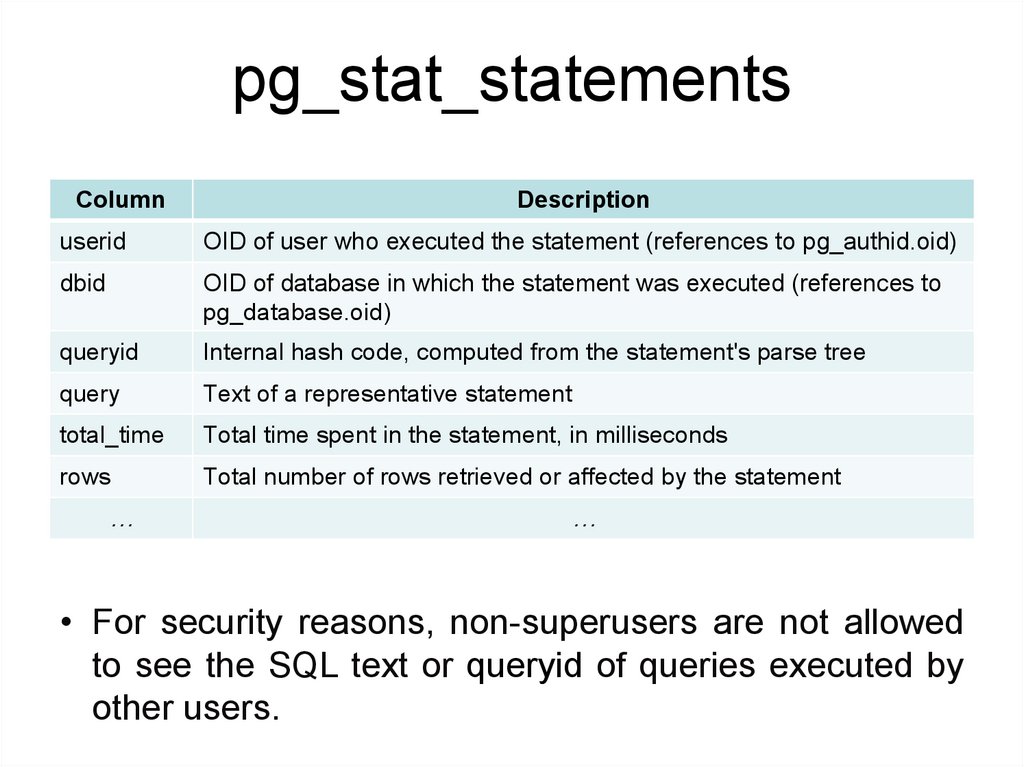

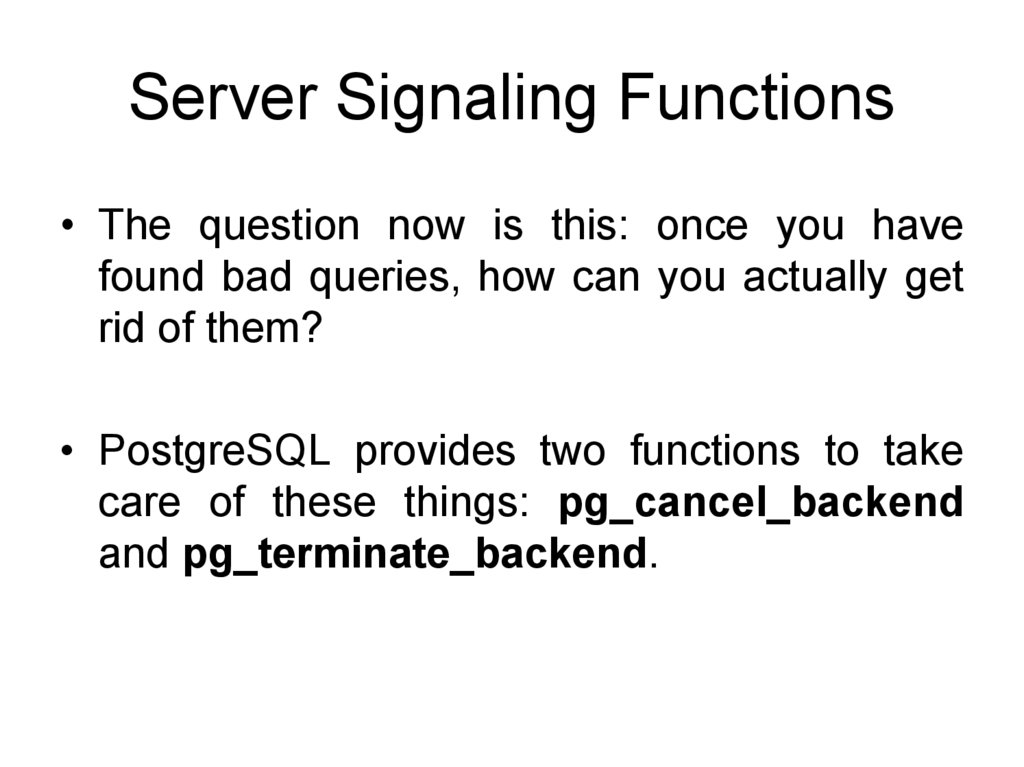






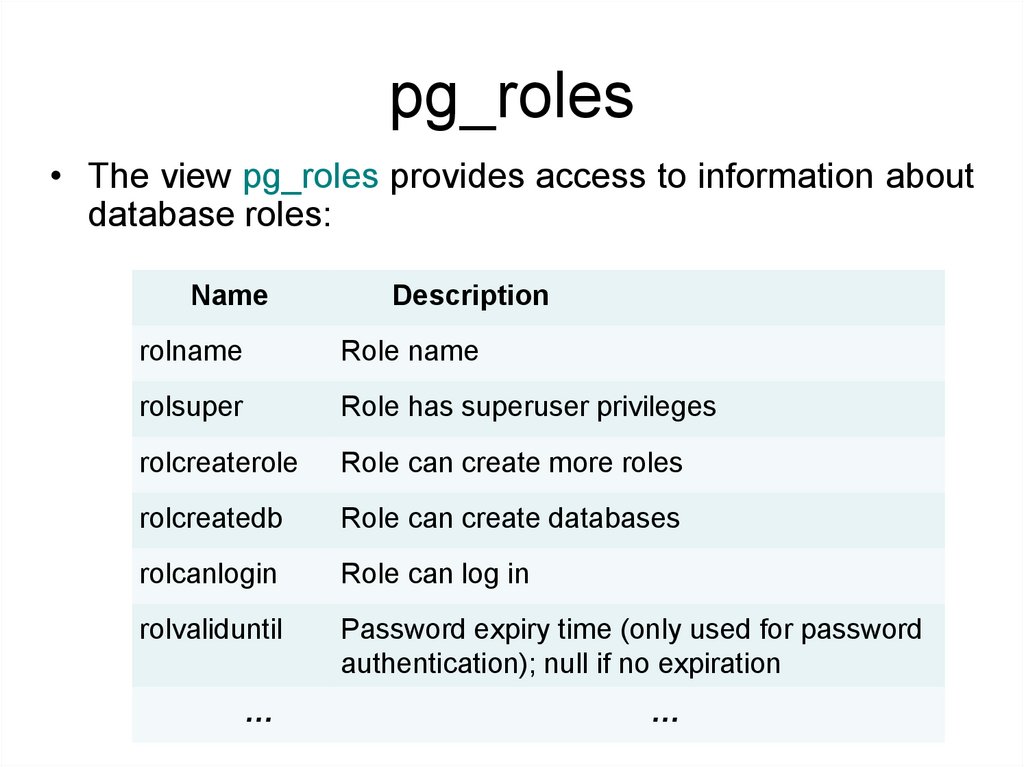
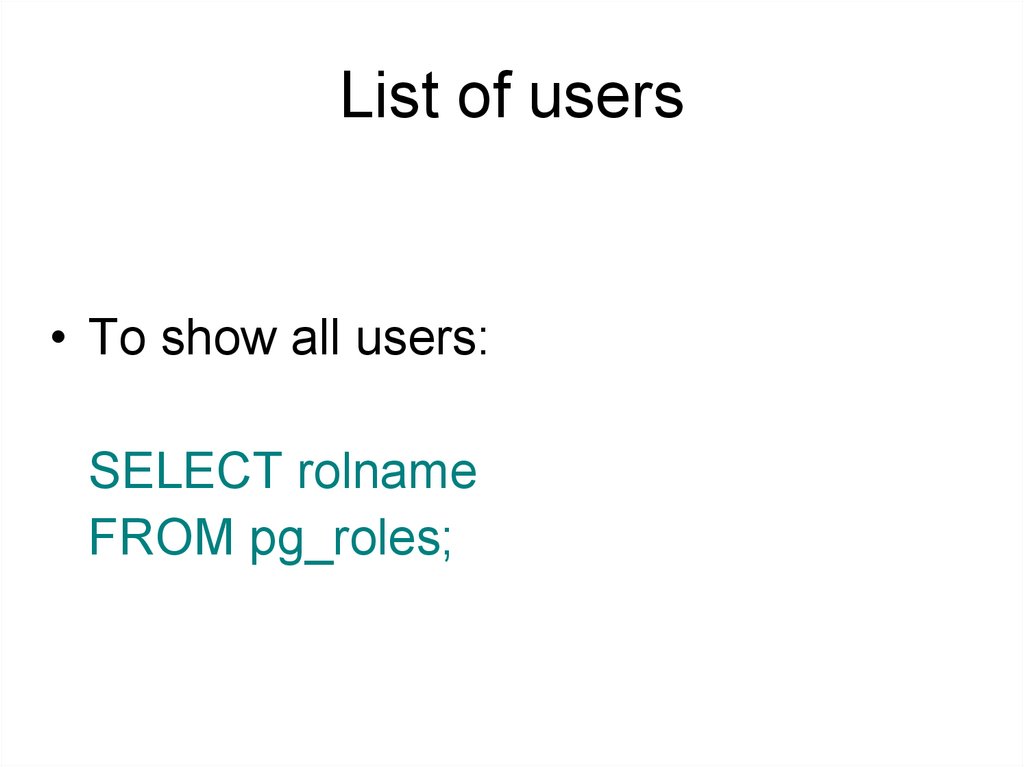
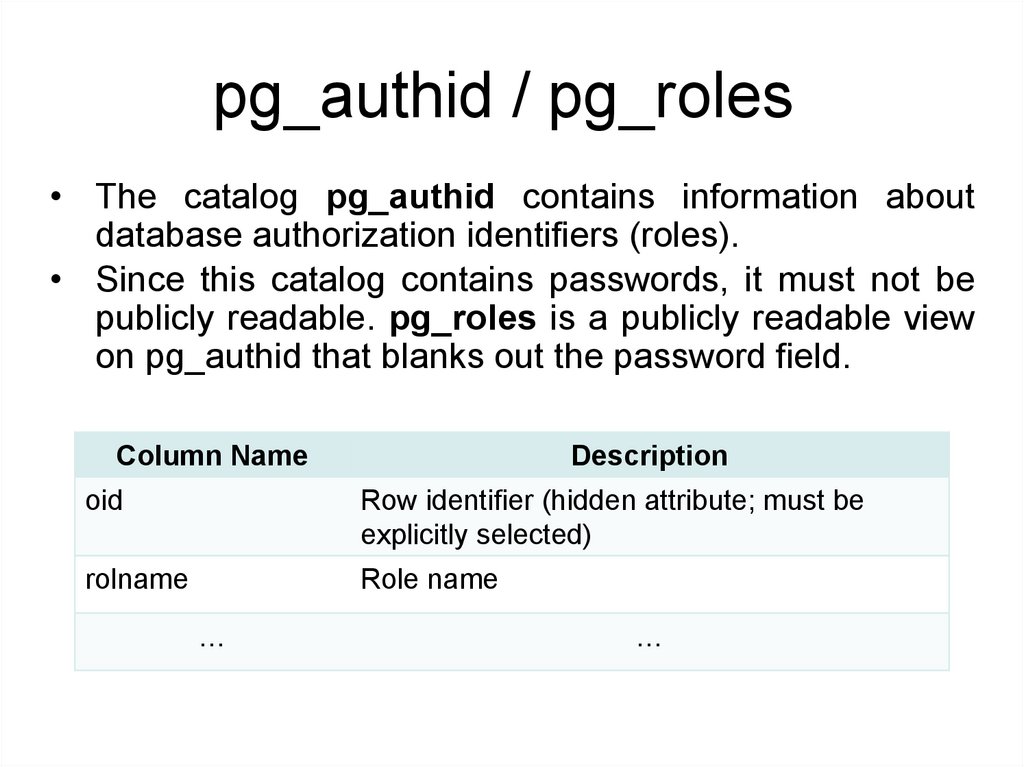
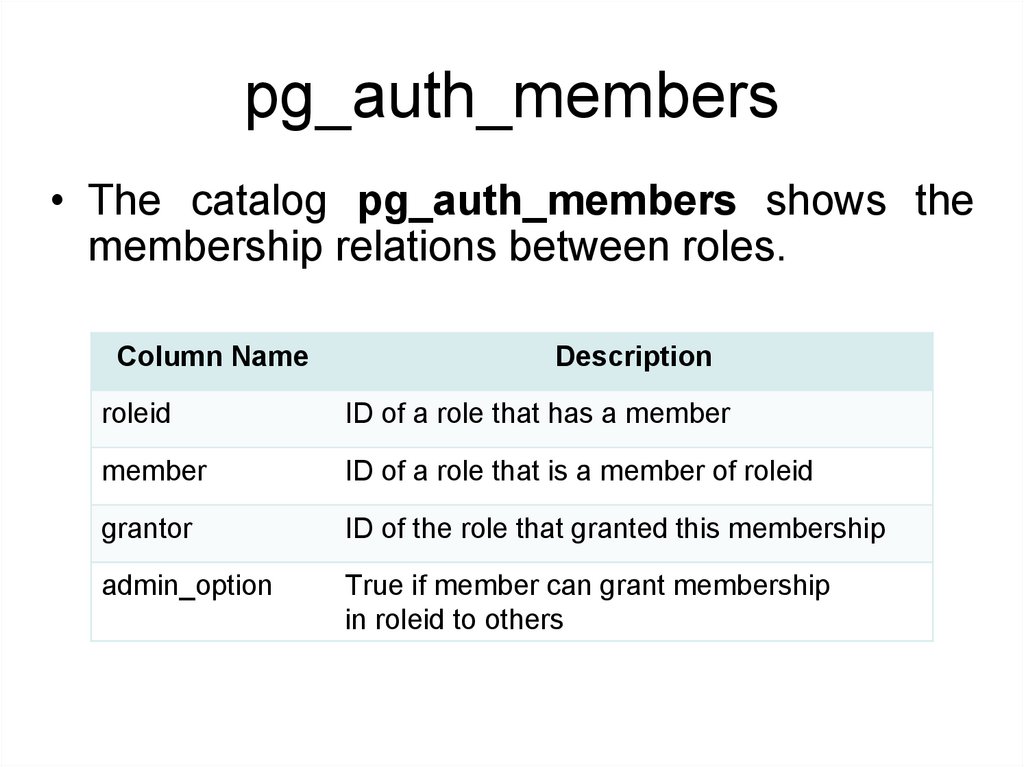

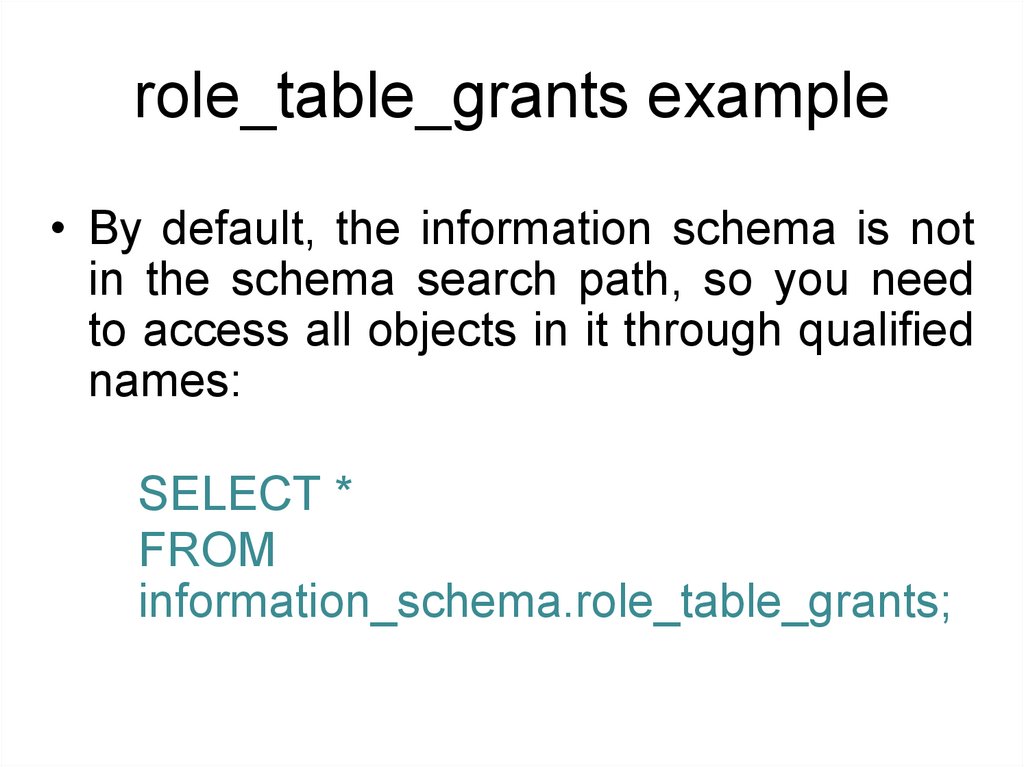
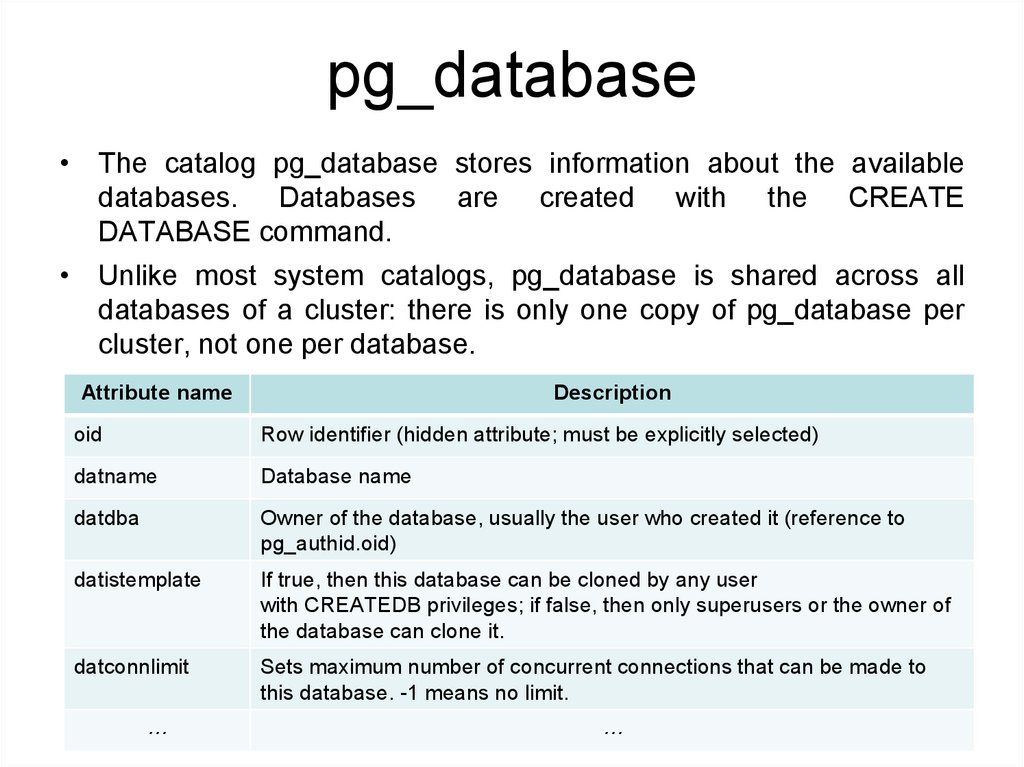





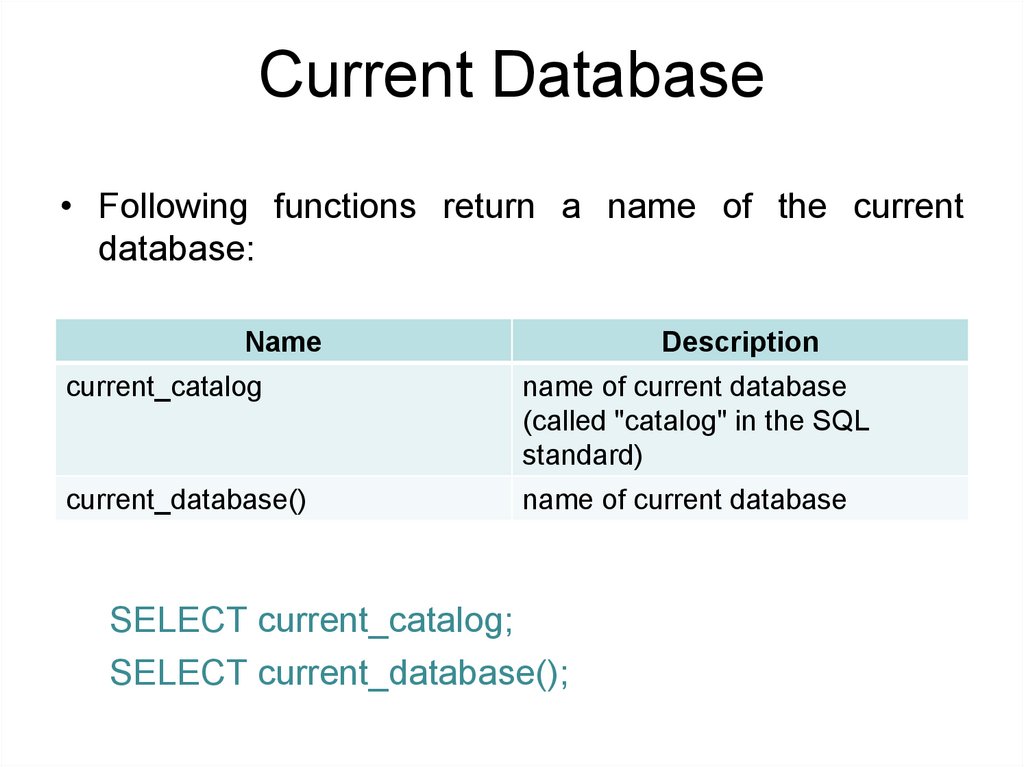
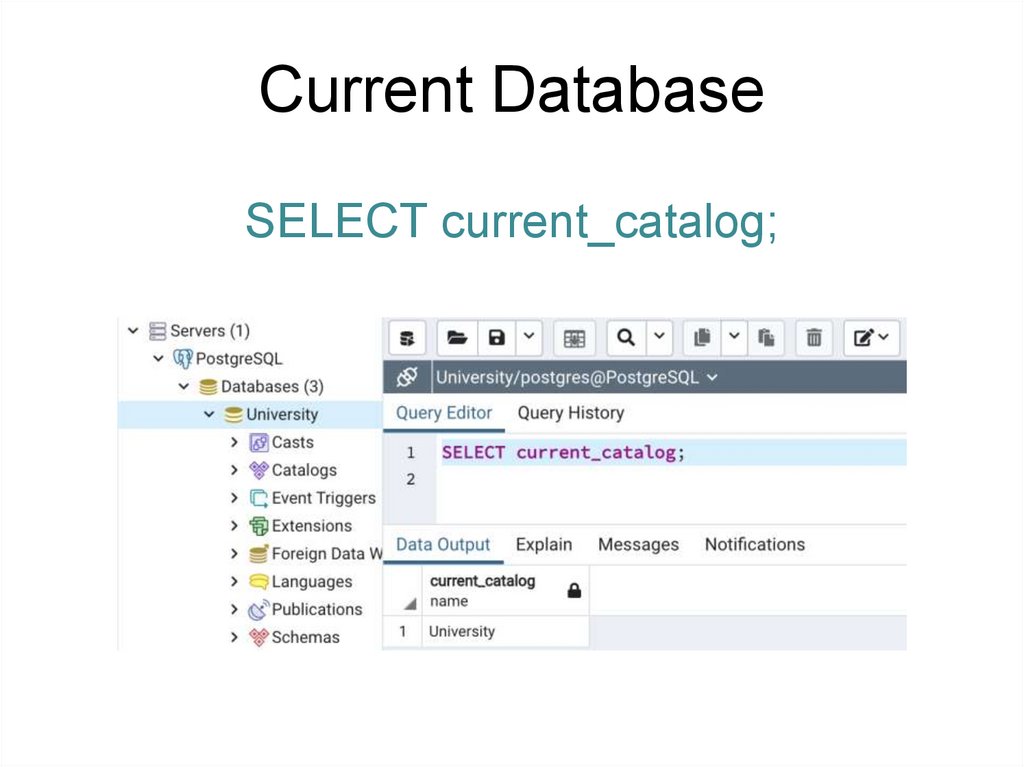
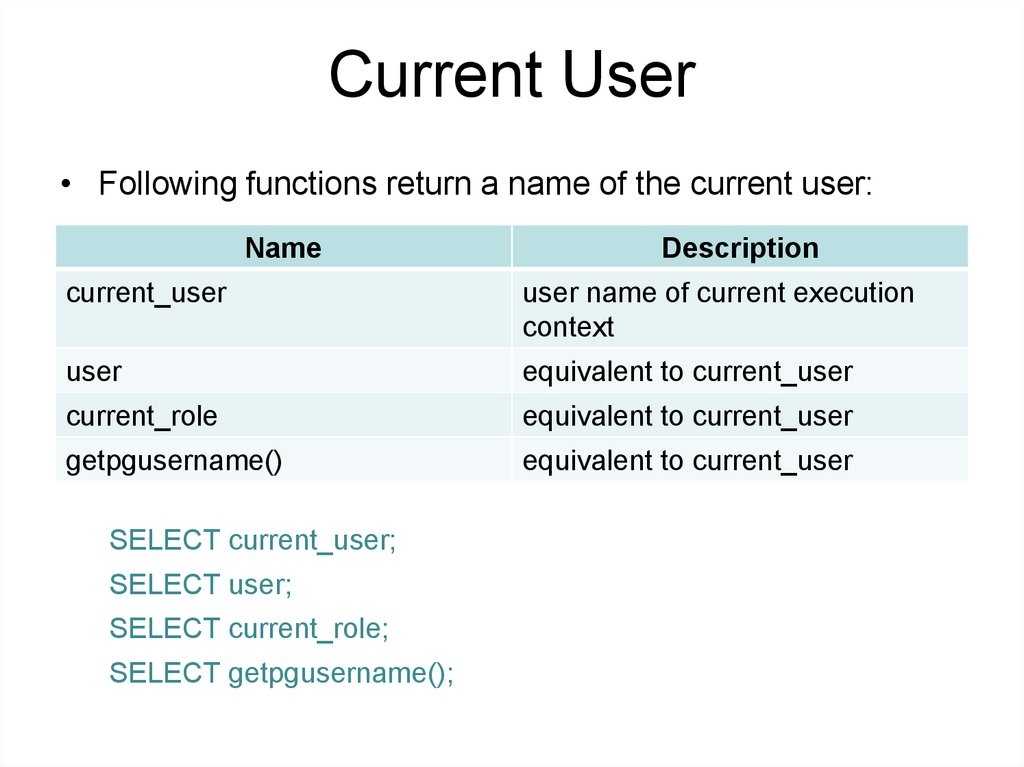


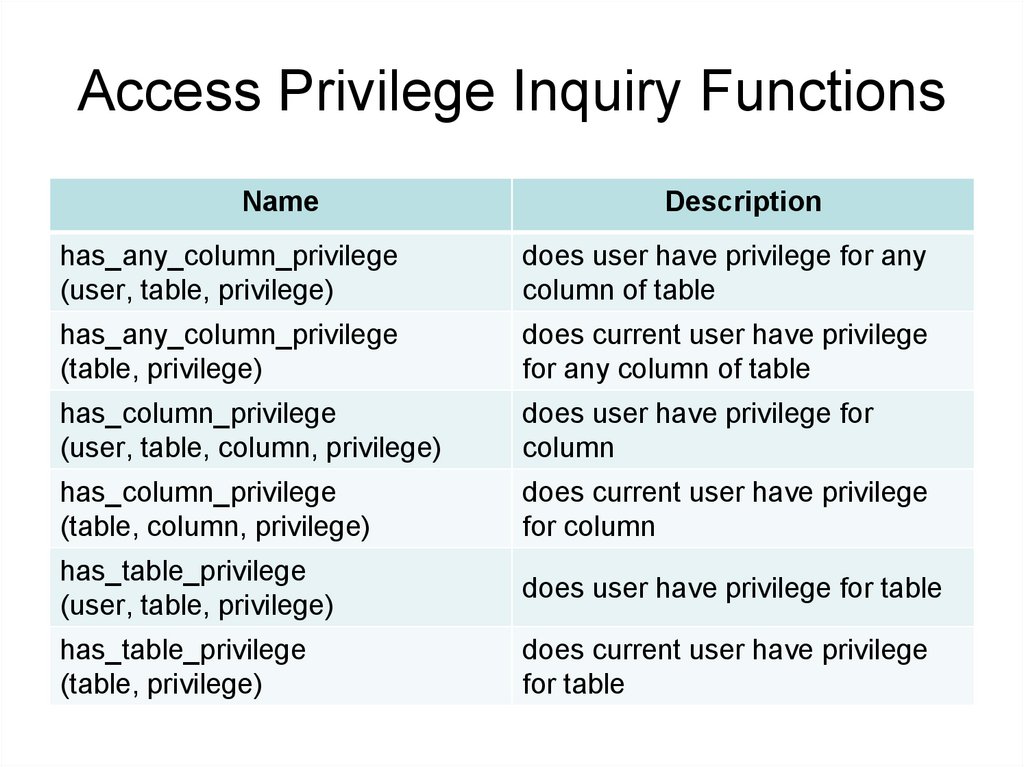
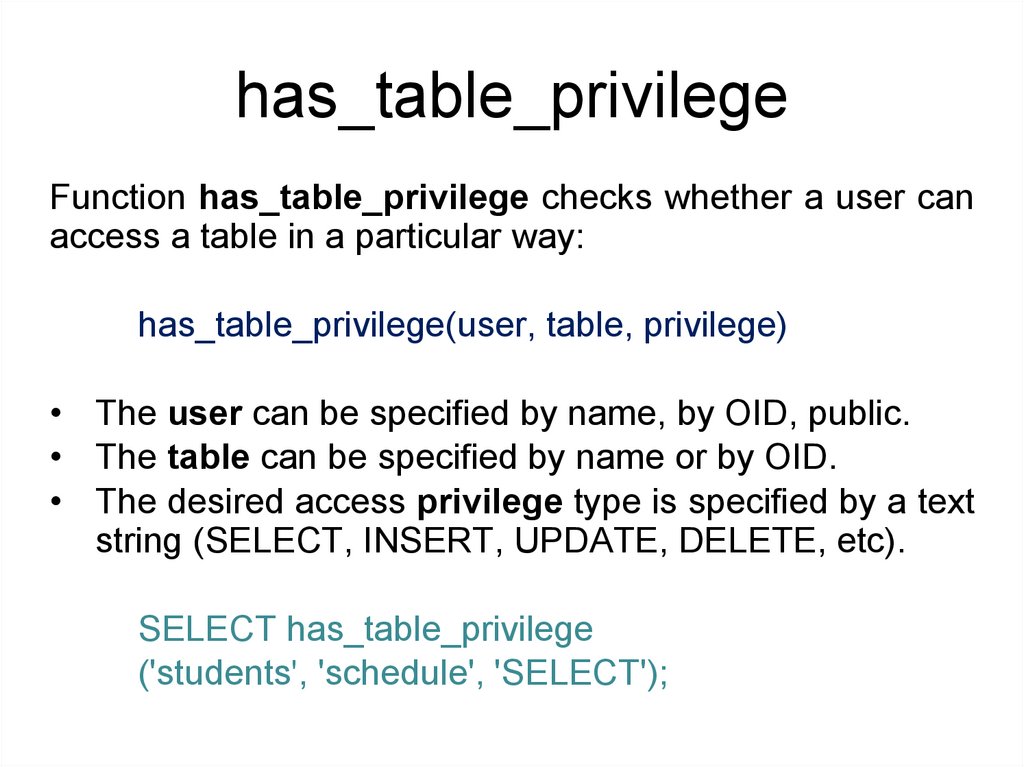




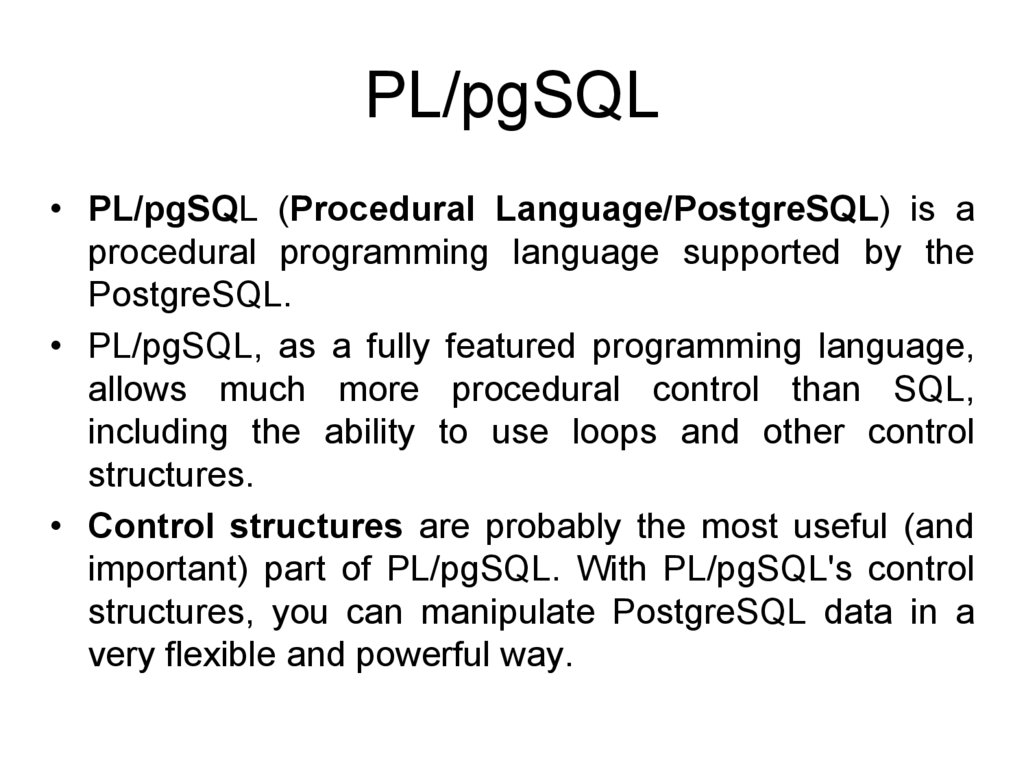
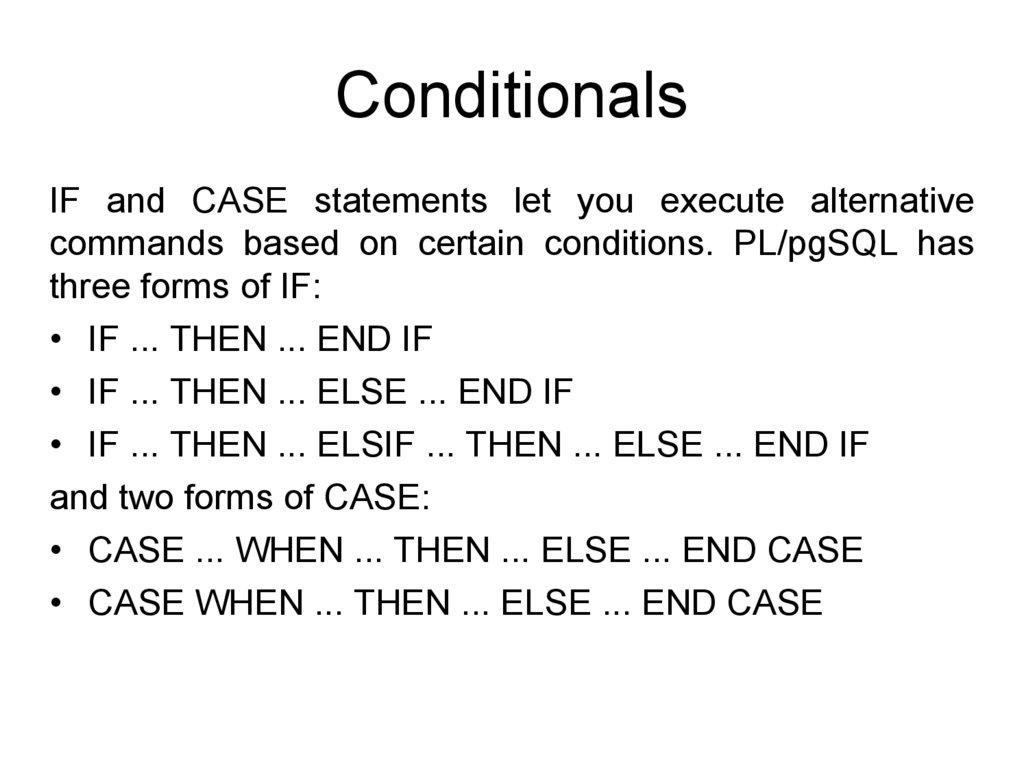
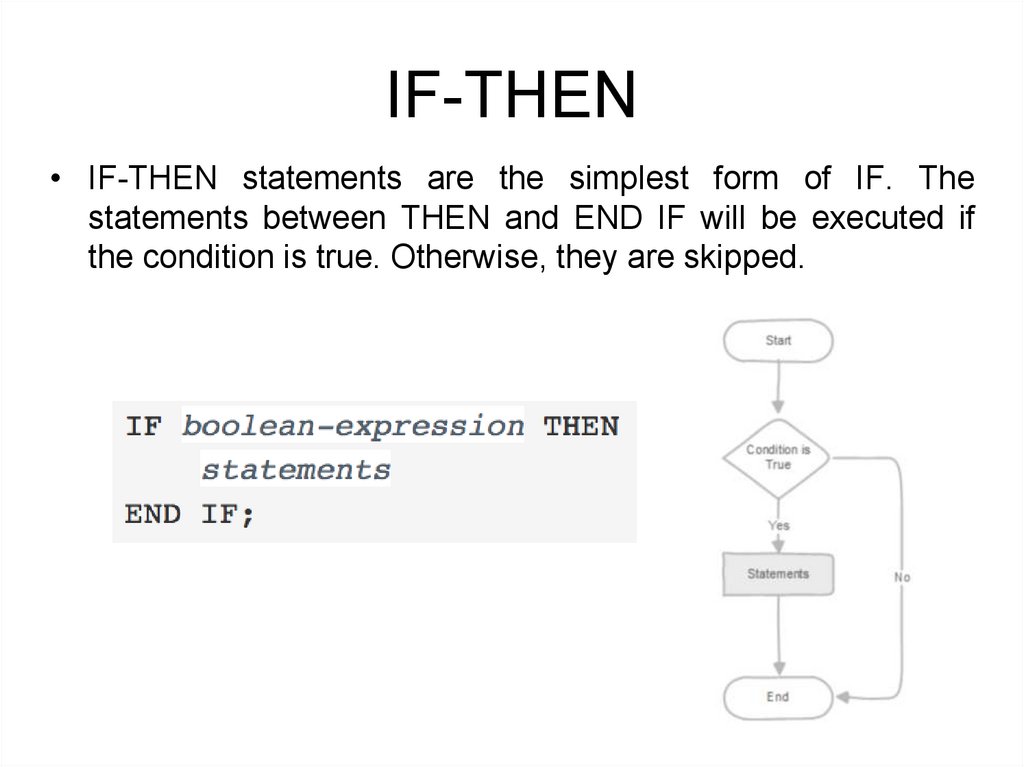
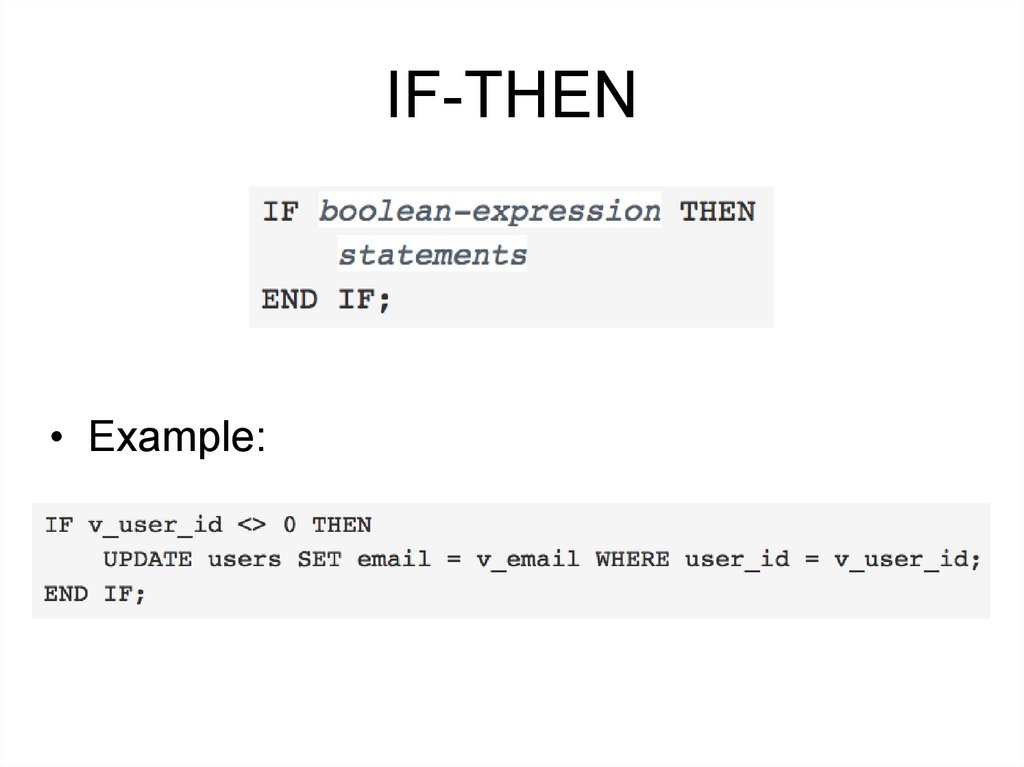
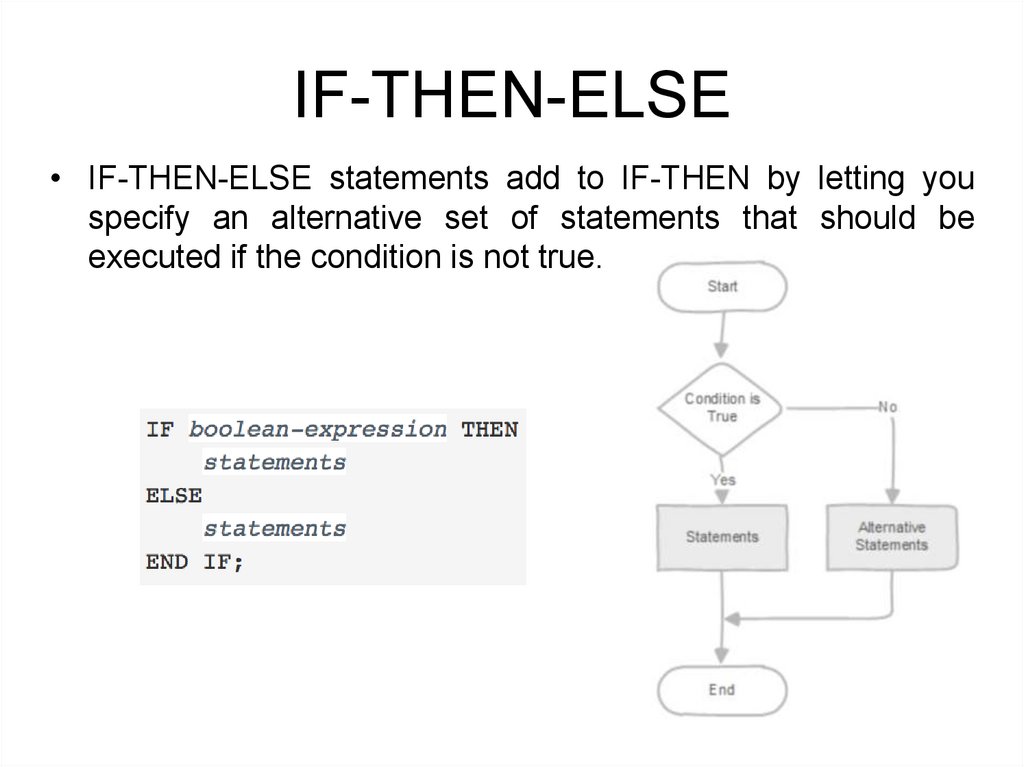




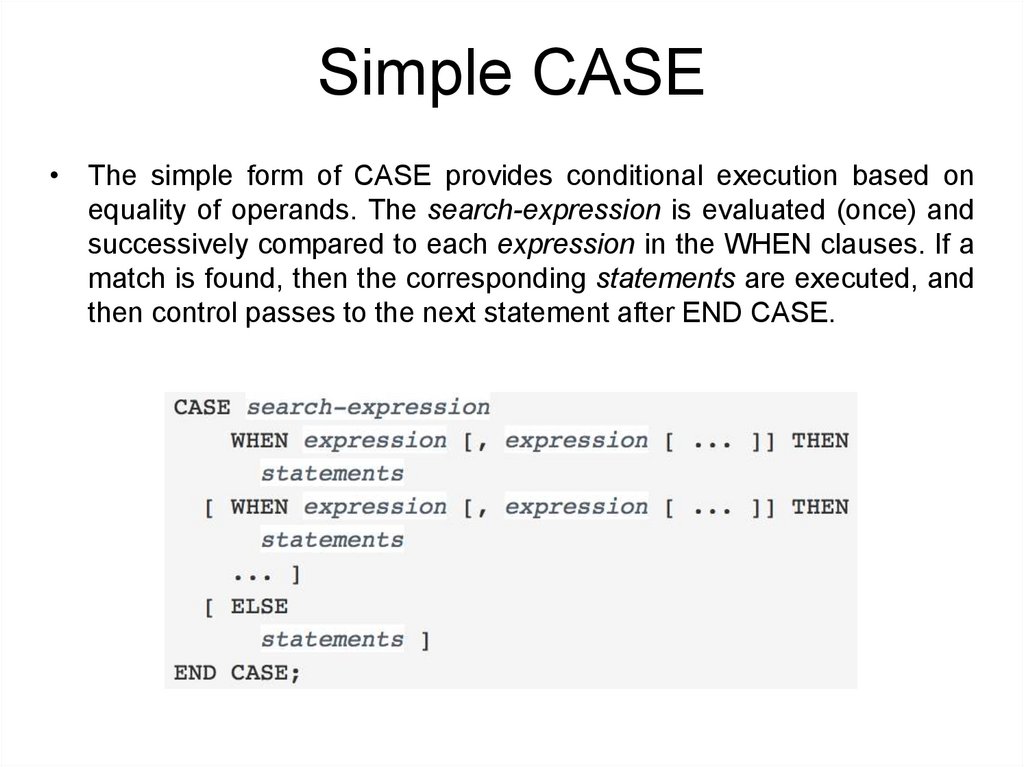
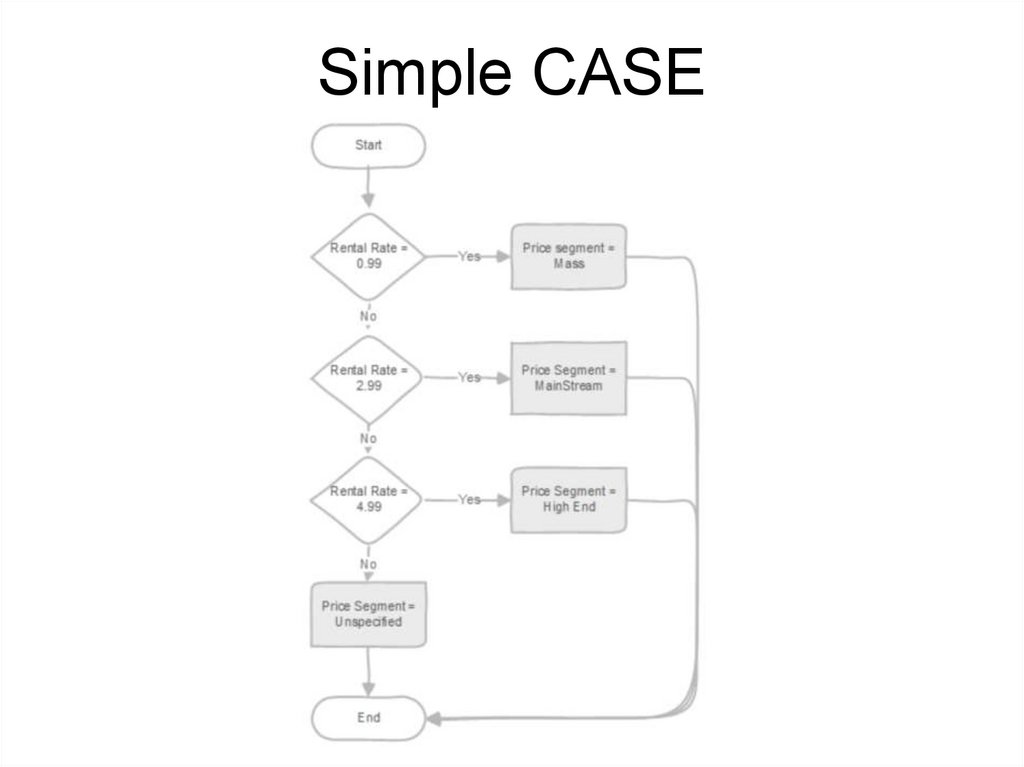


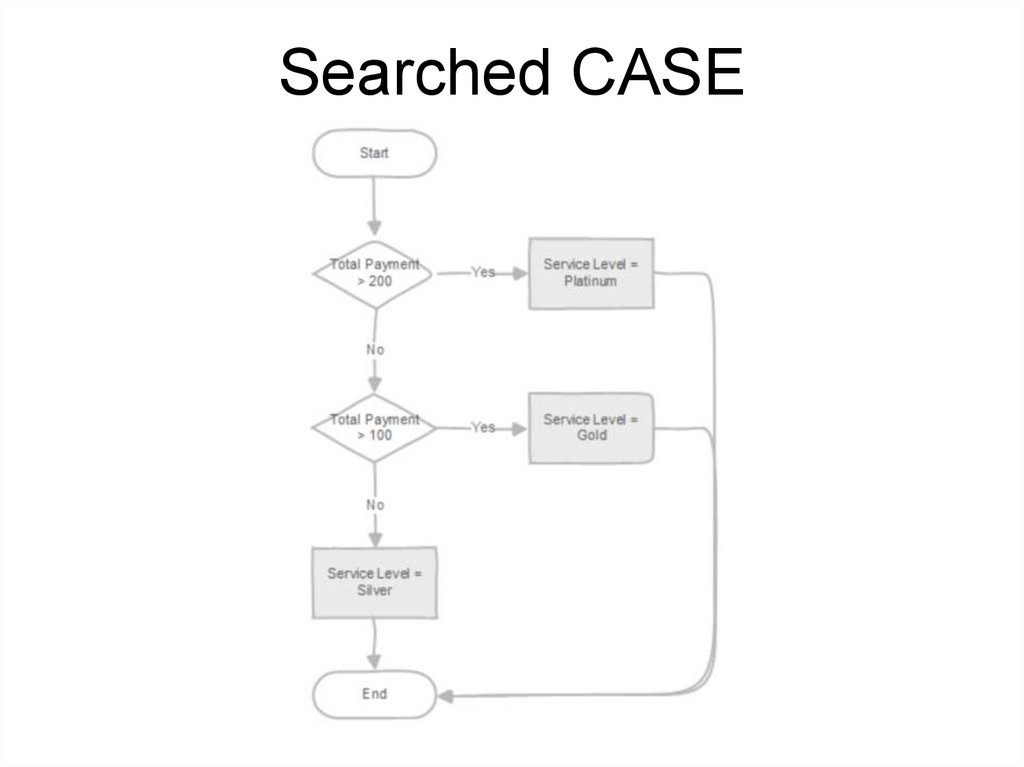

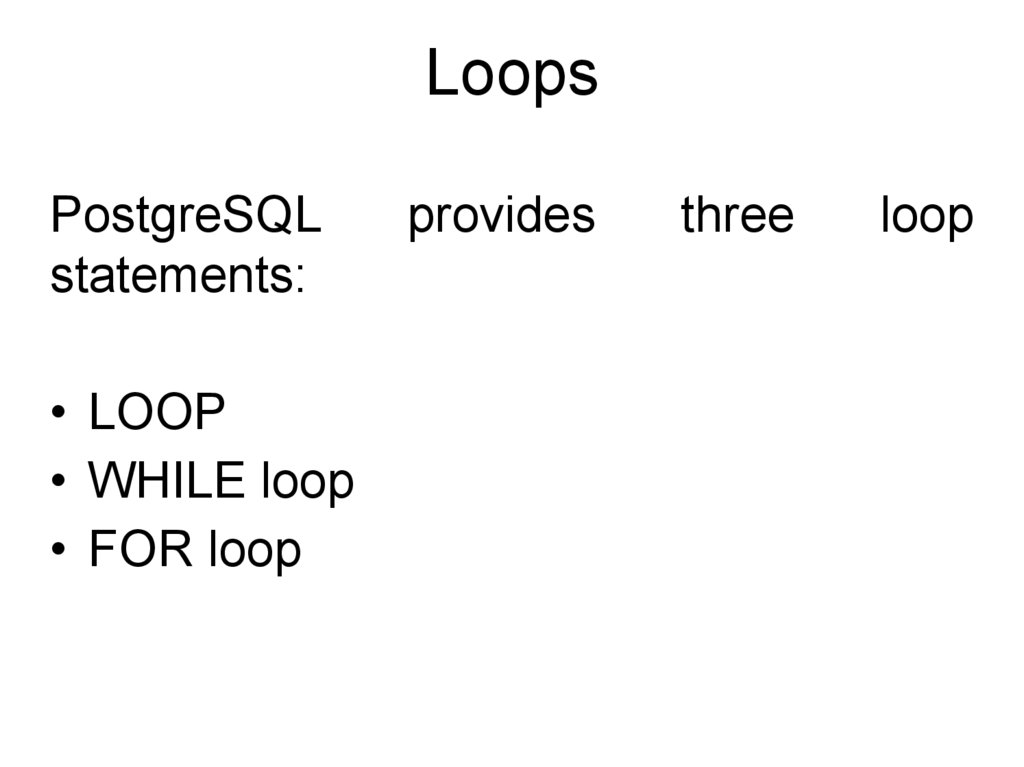

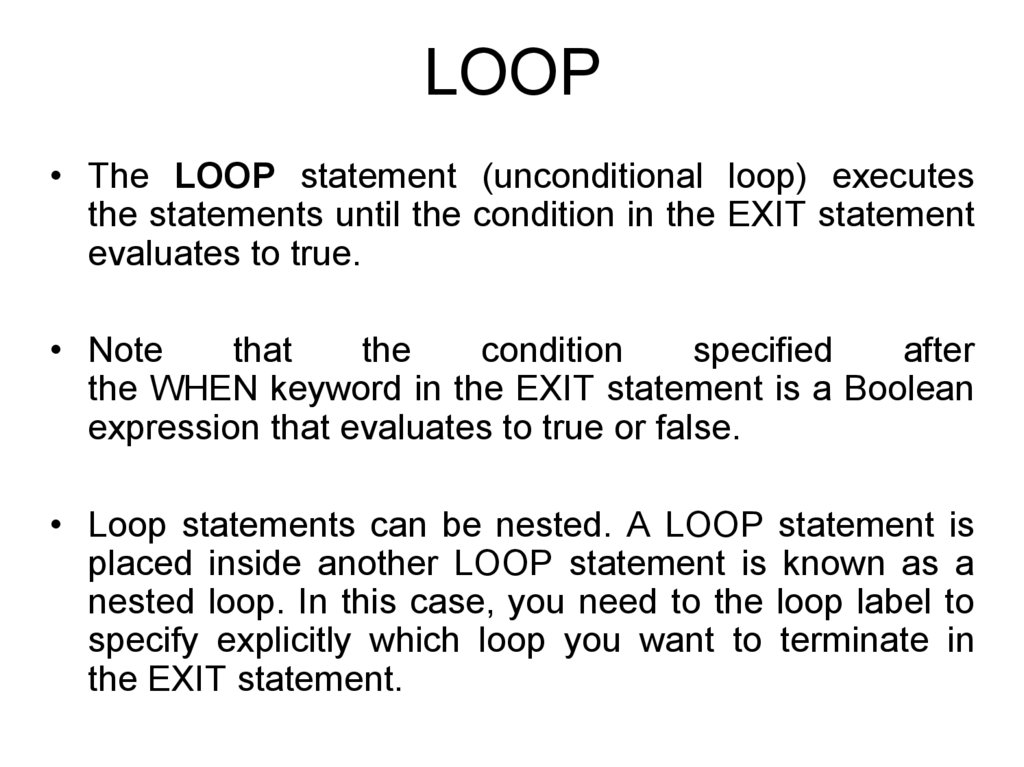


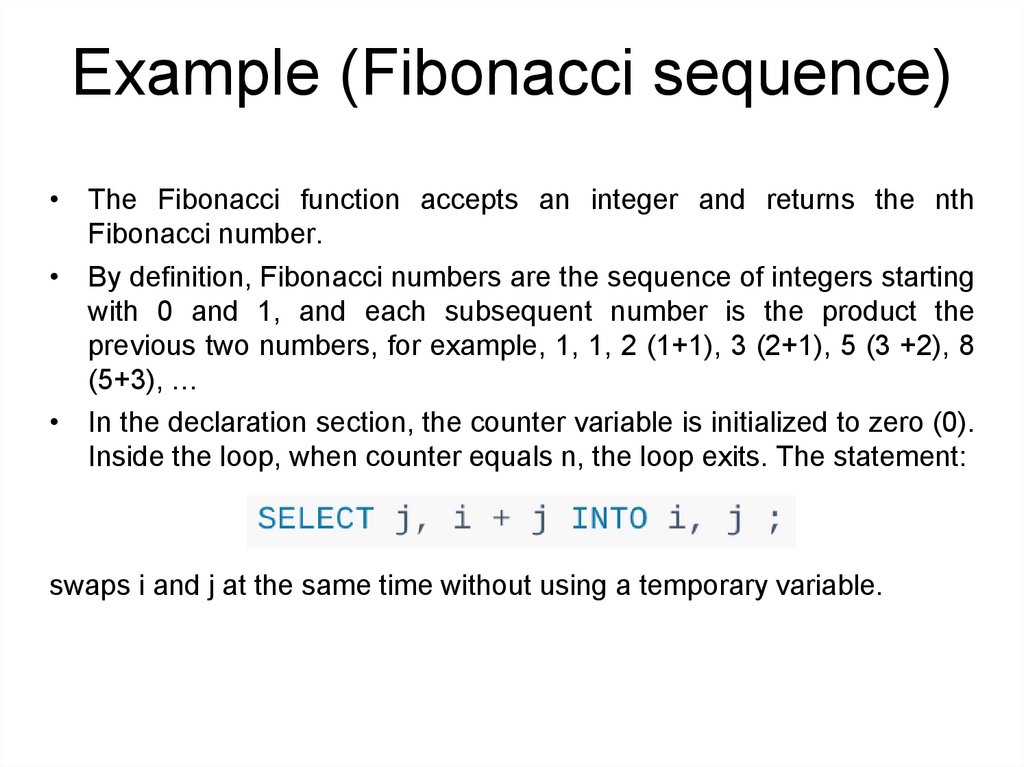
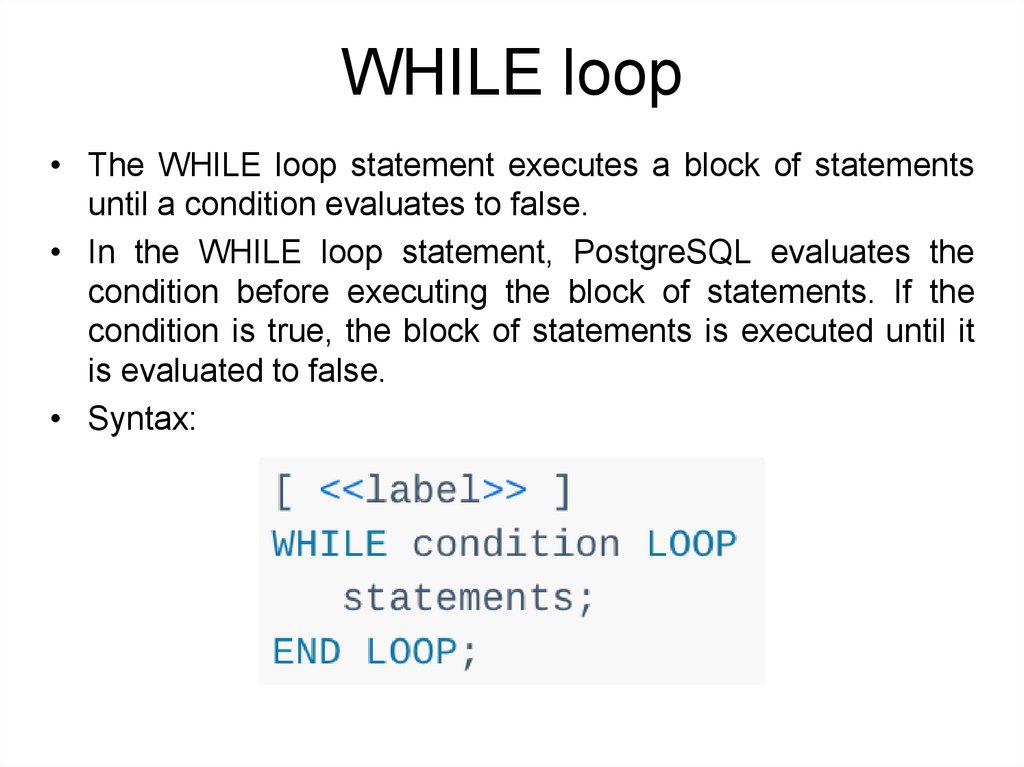
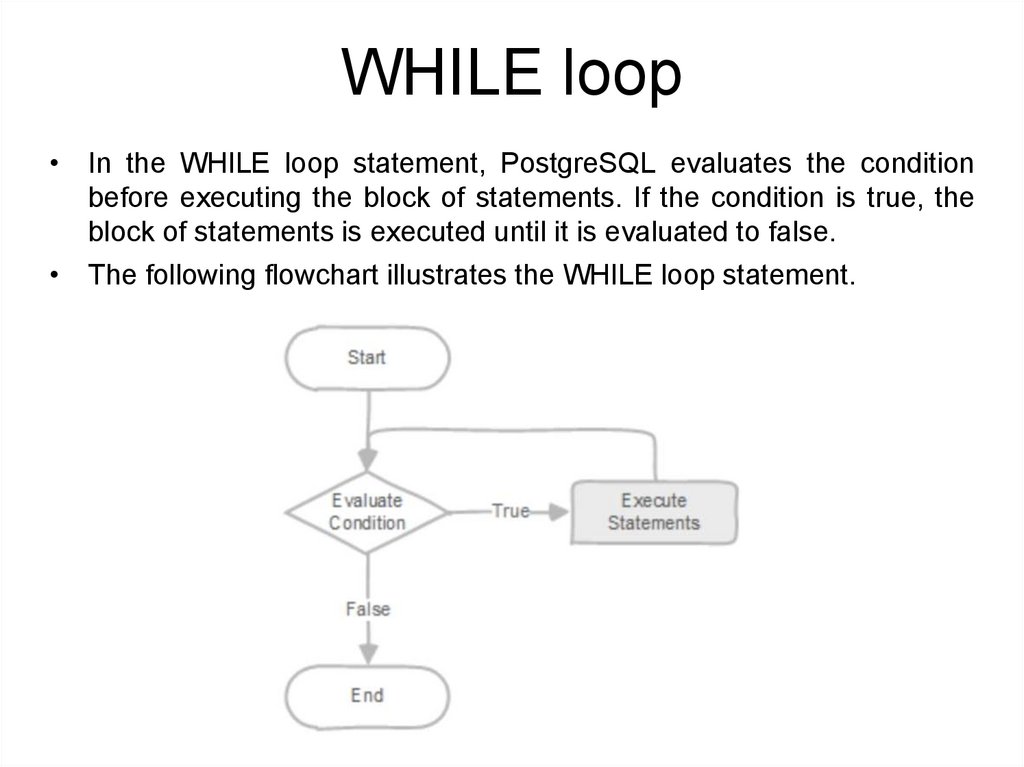
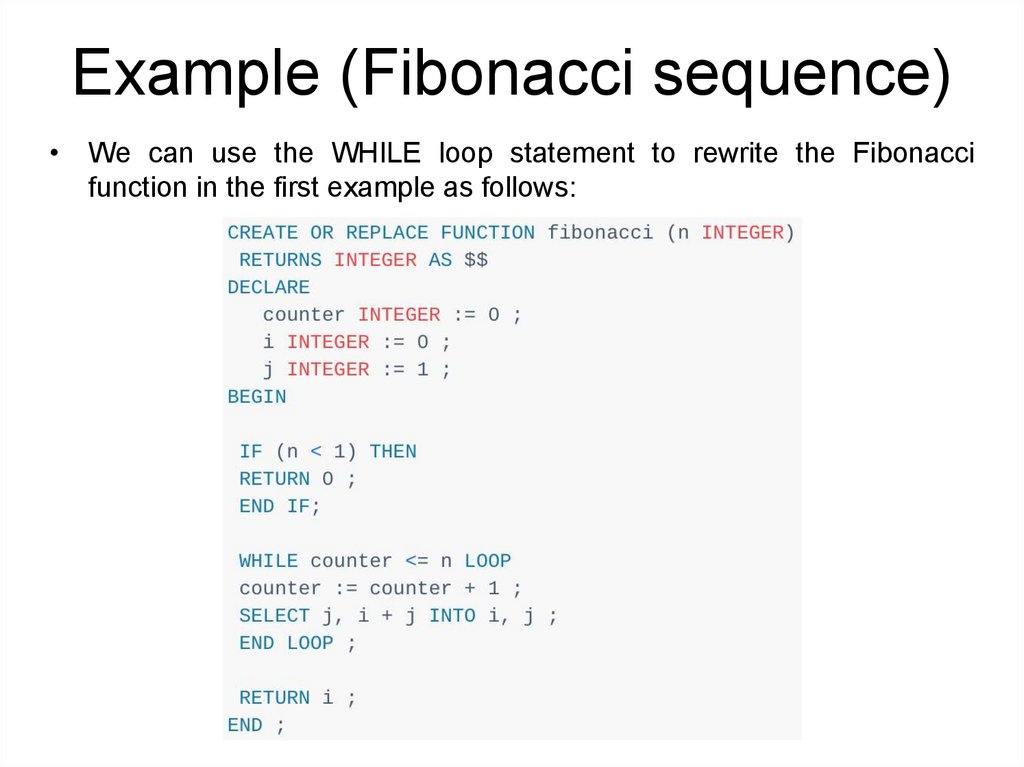
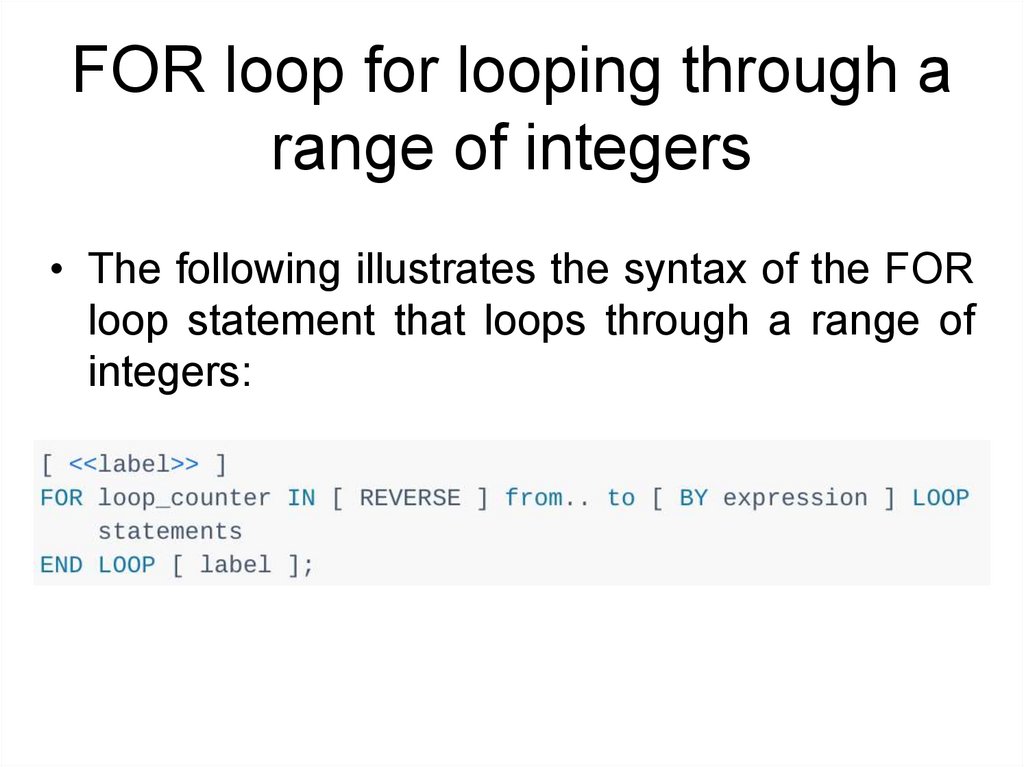

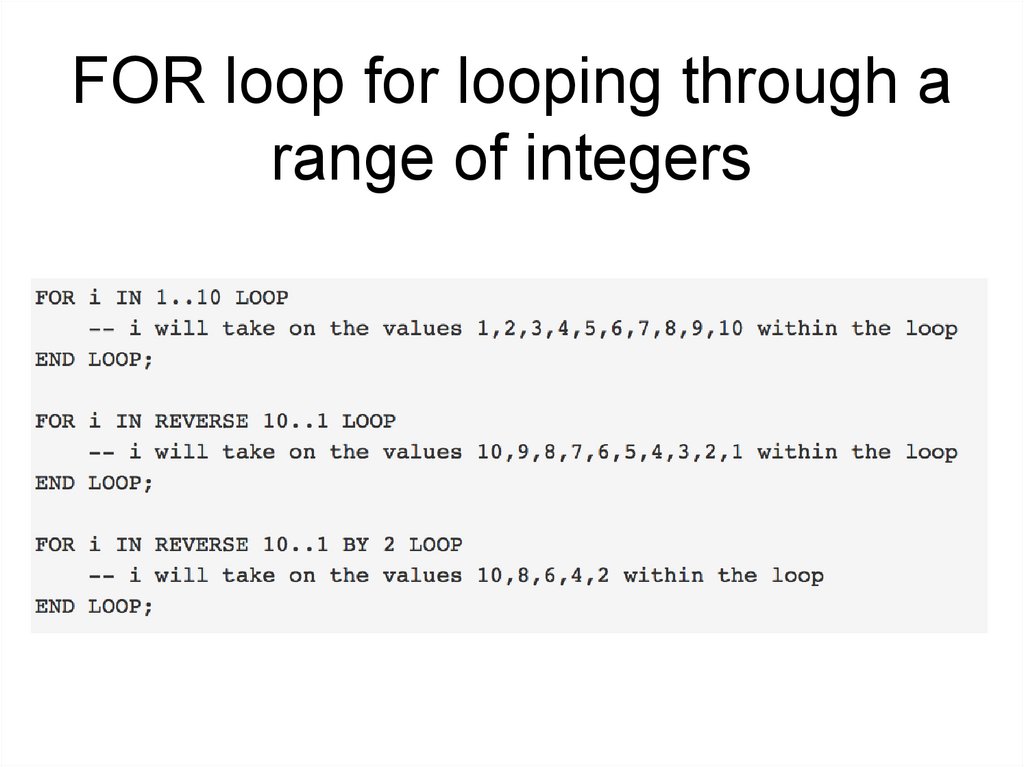

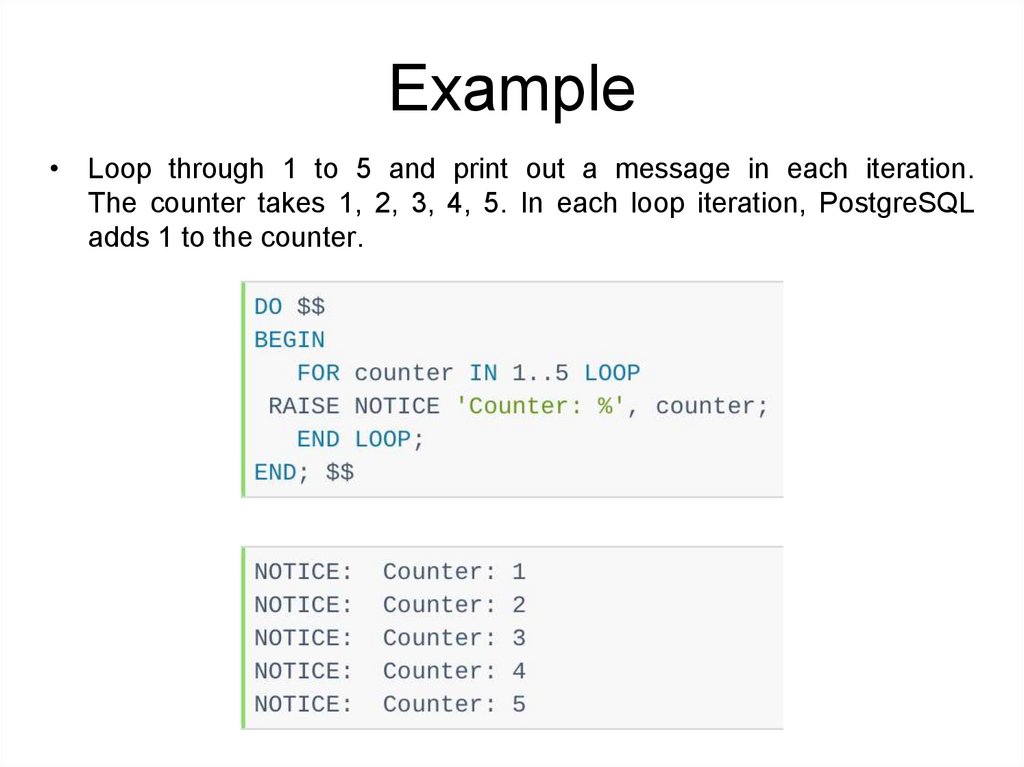

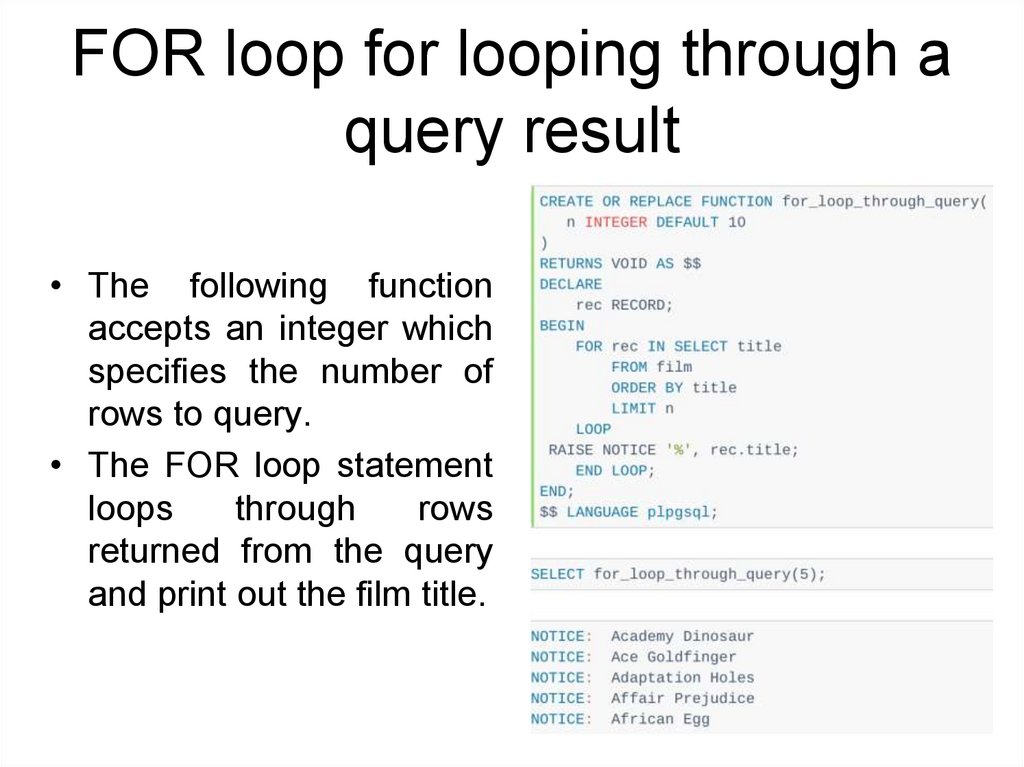

 Информатика
Информатика Базы данных
Базы данных








